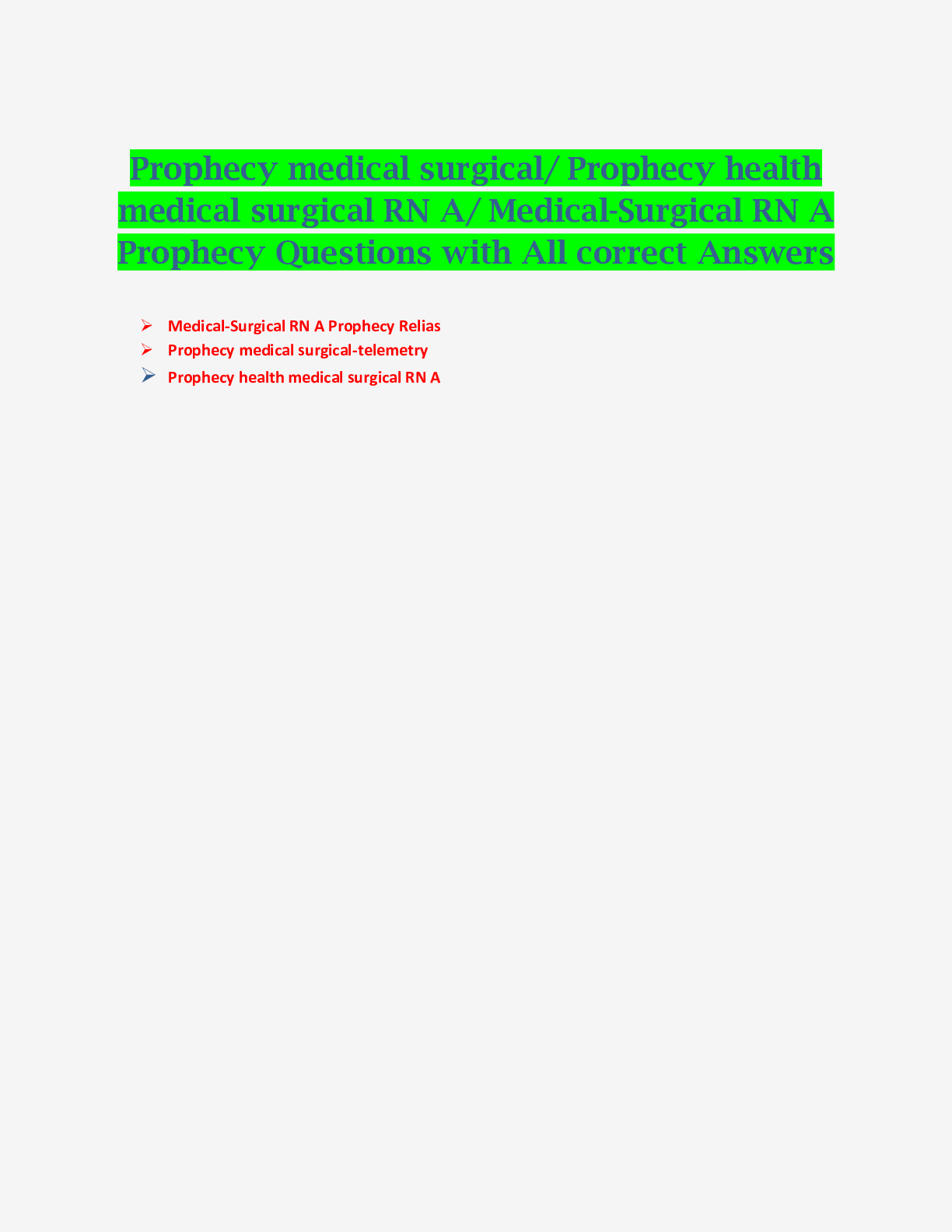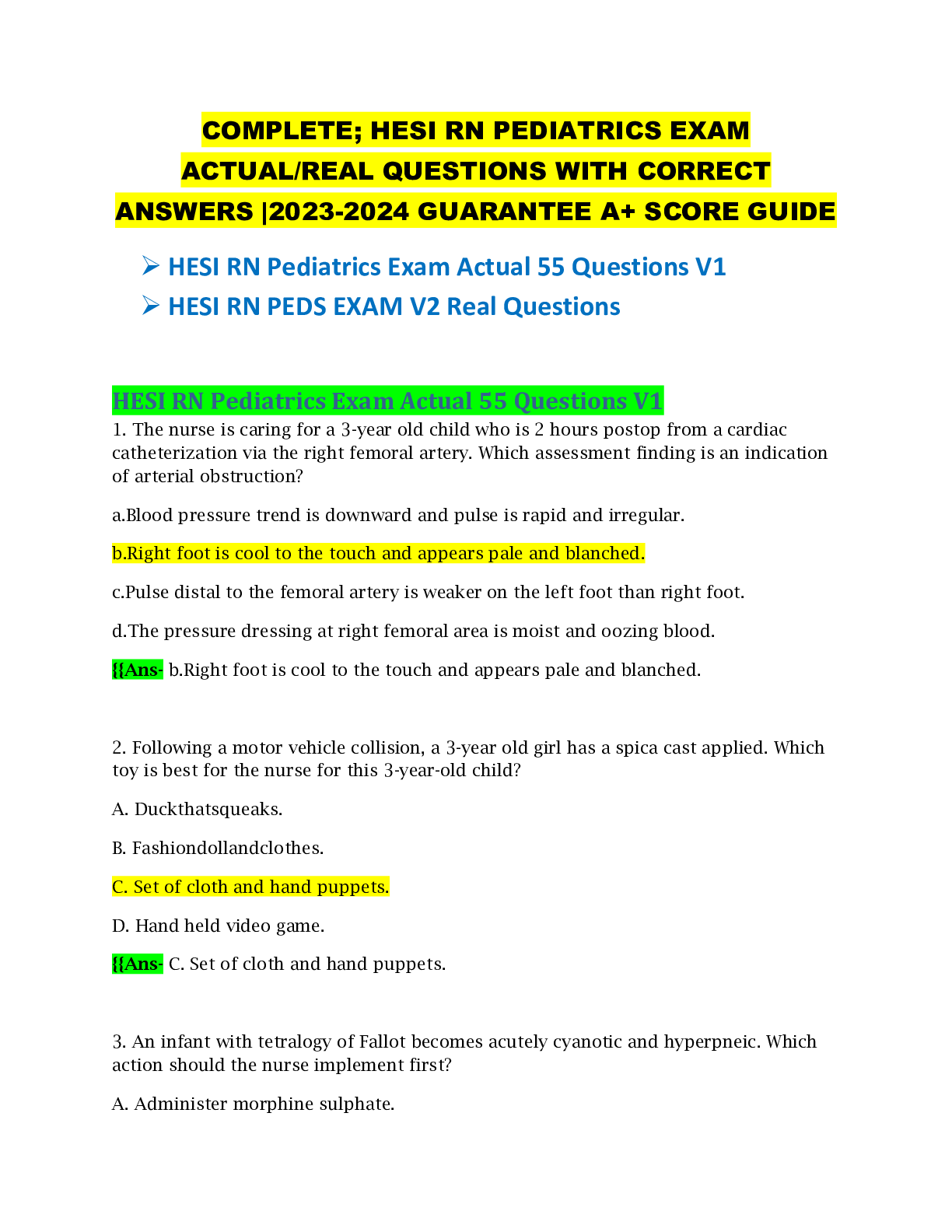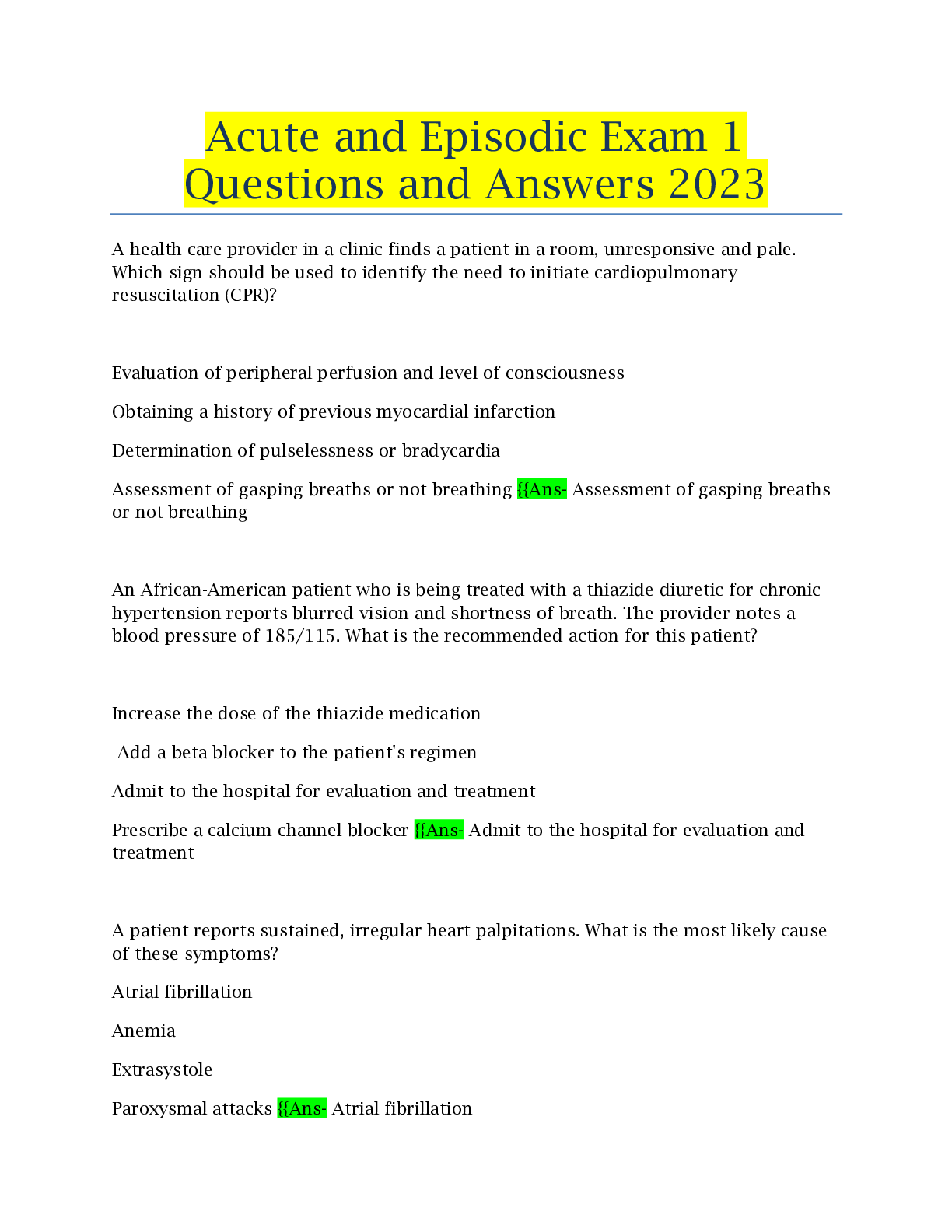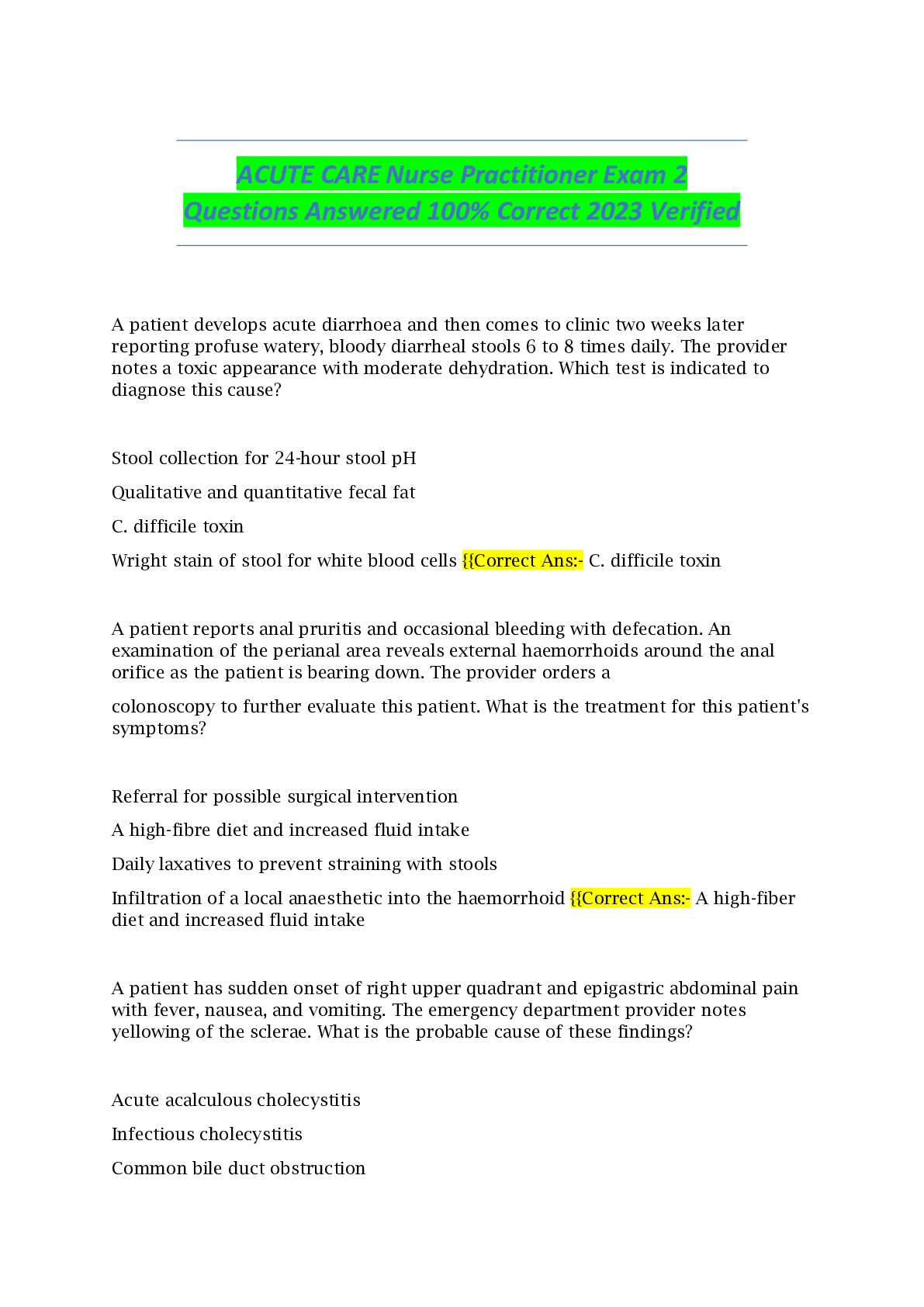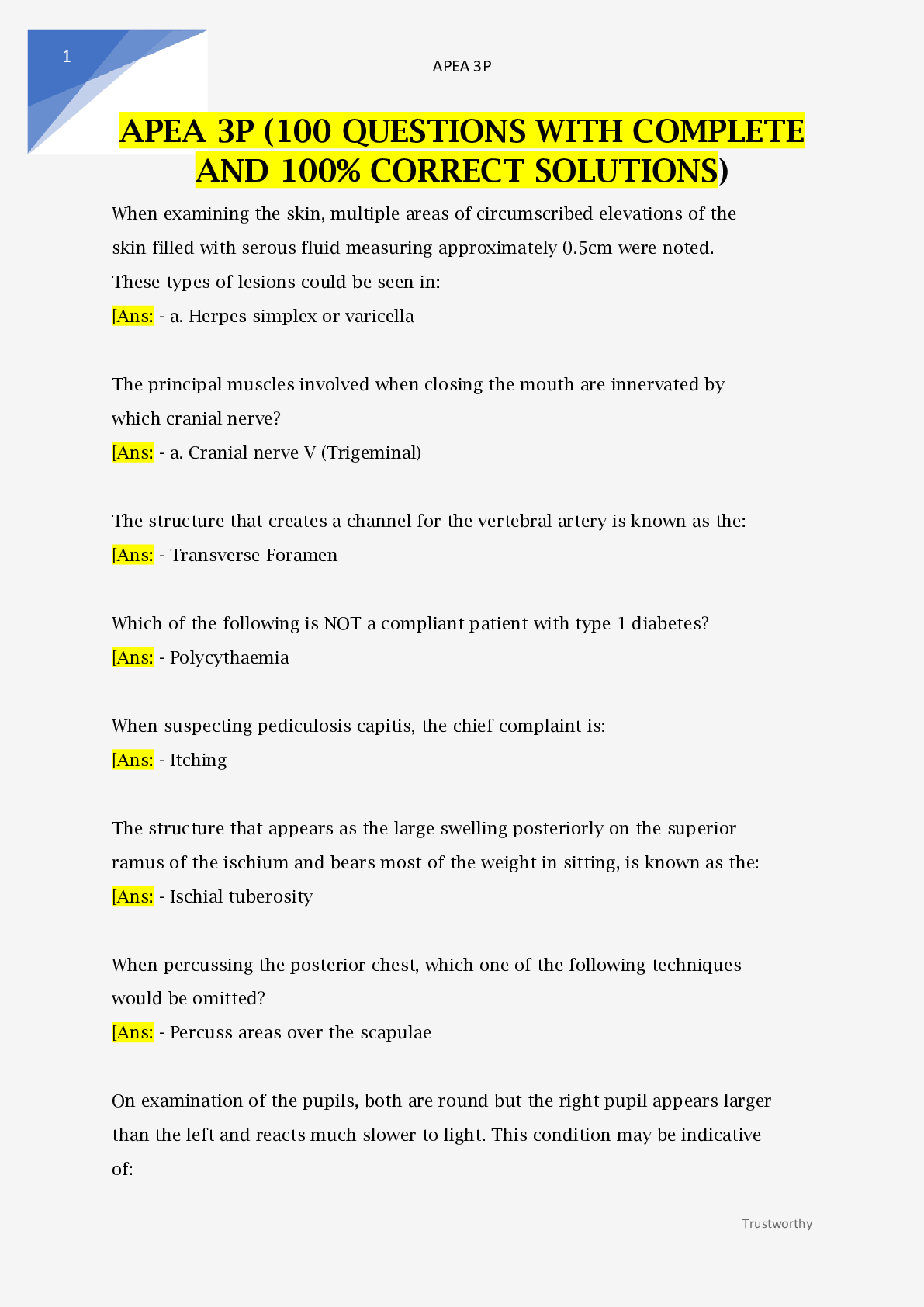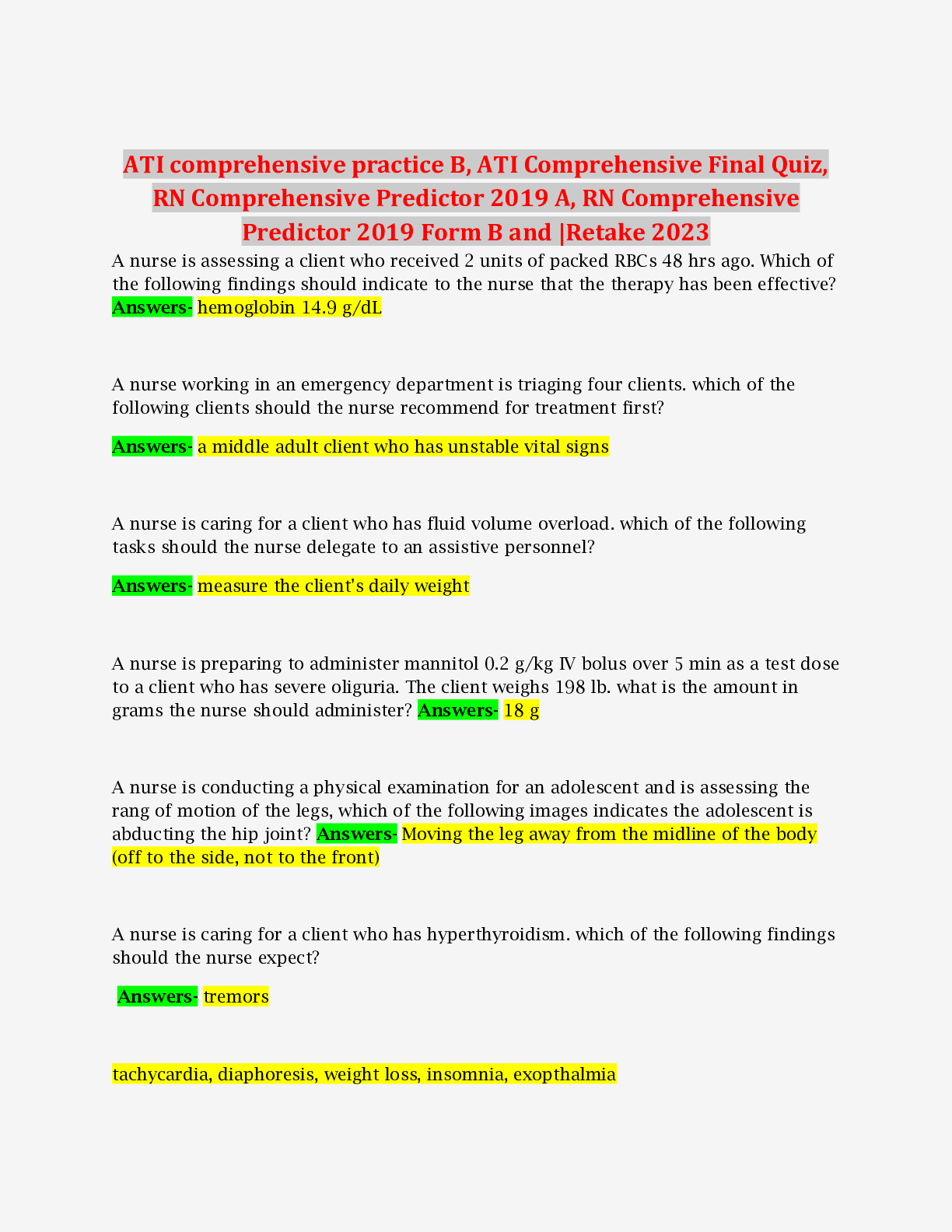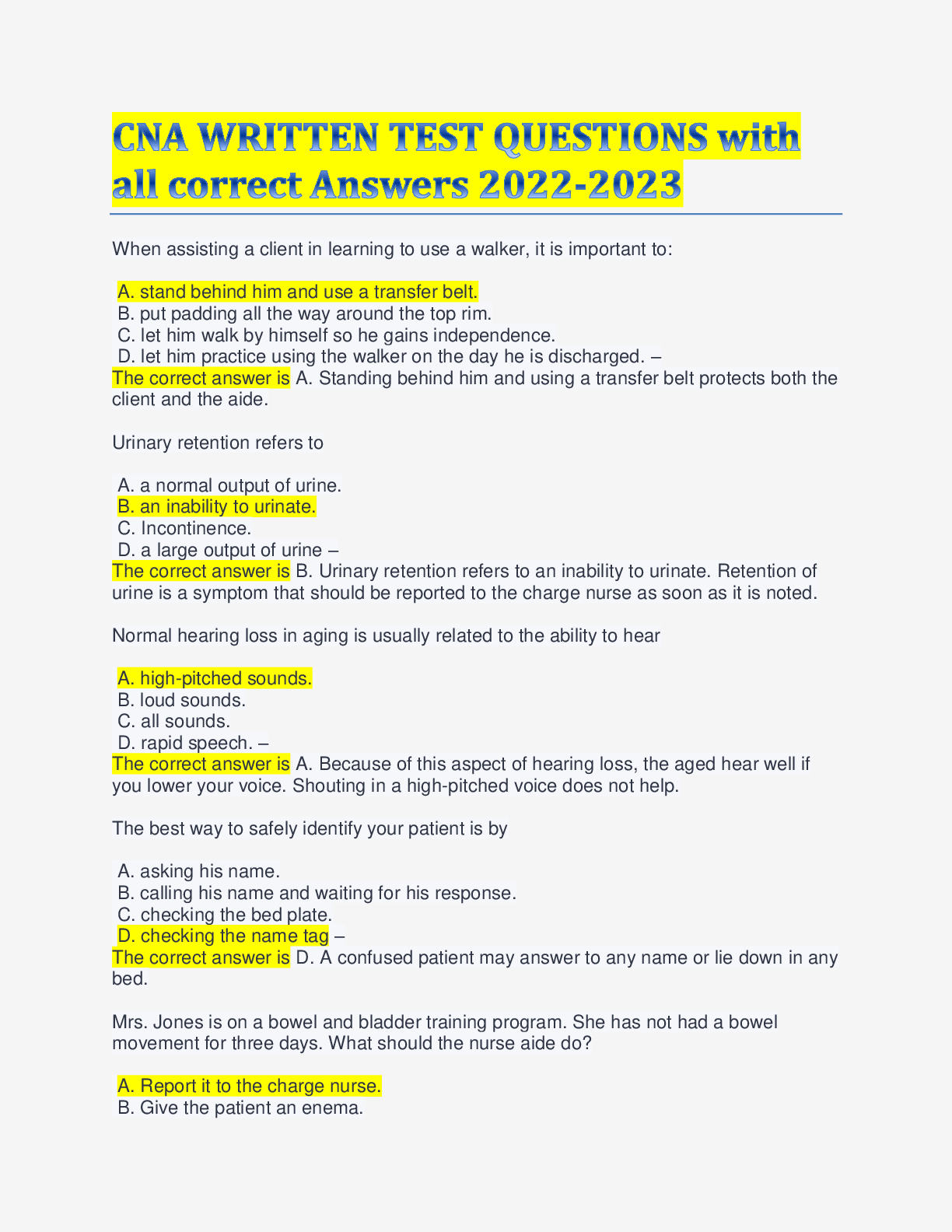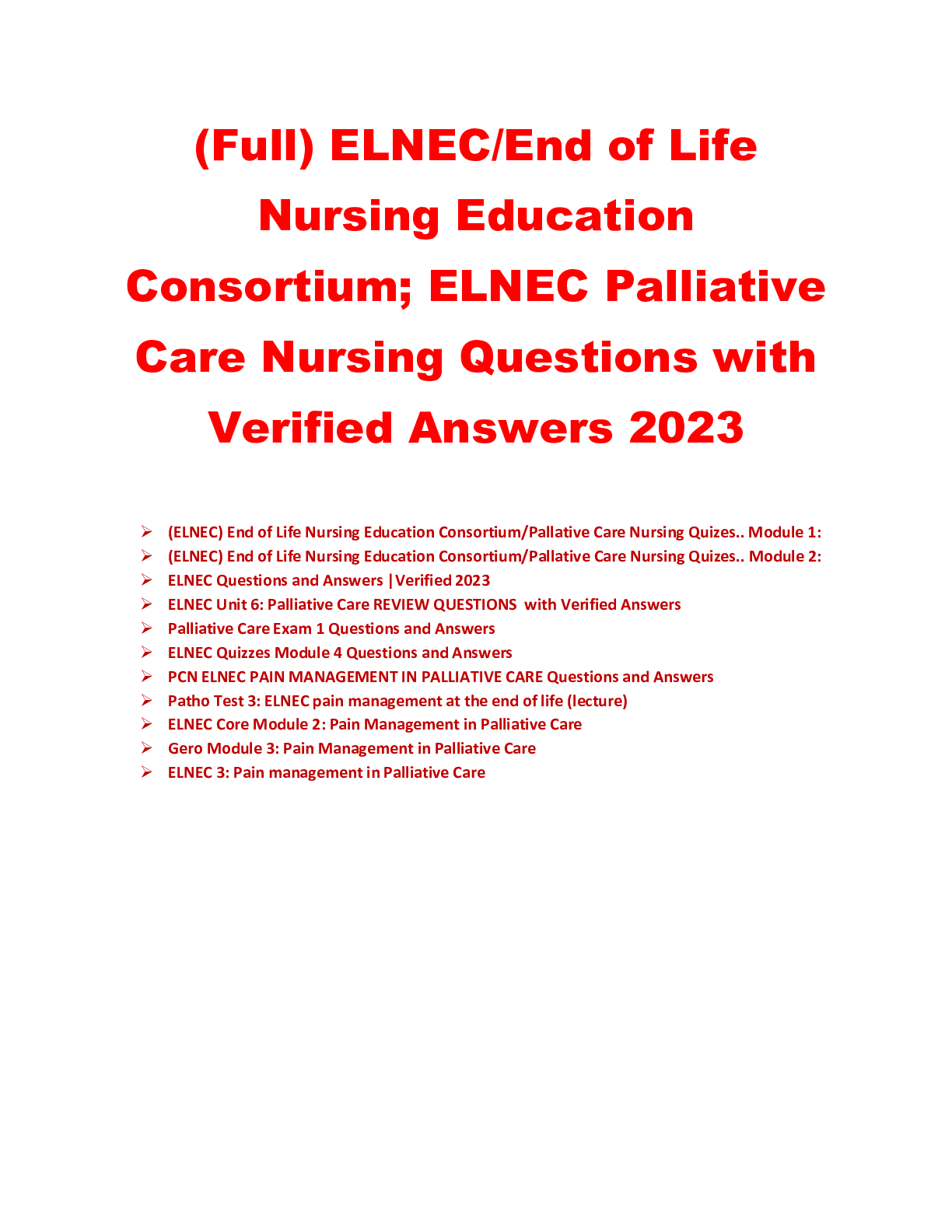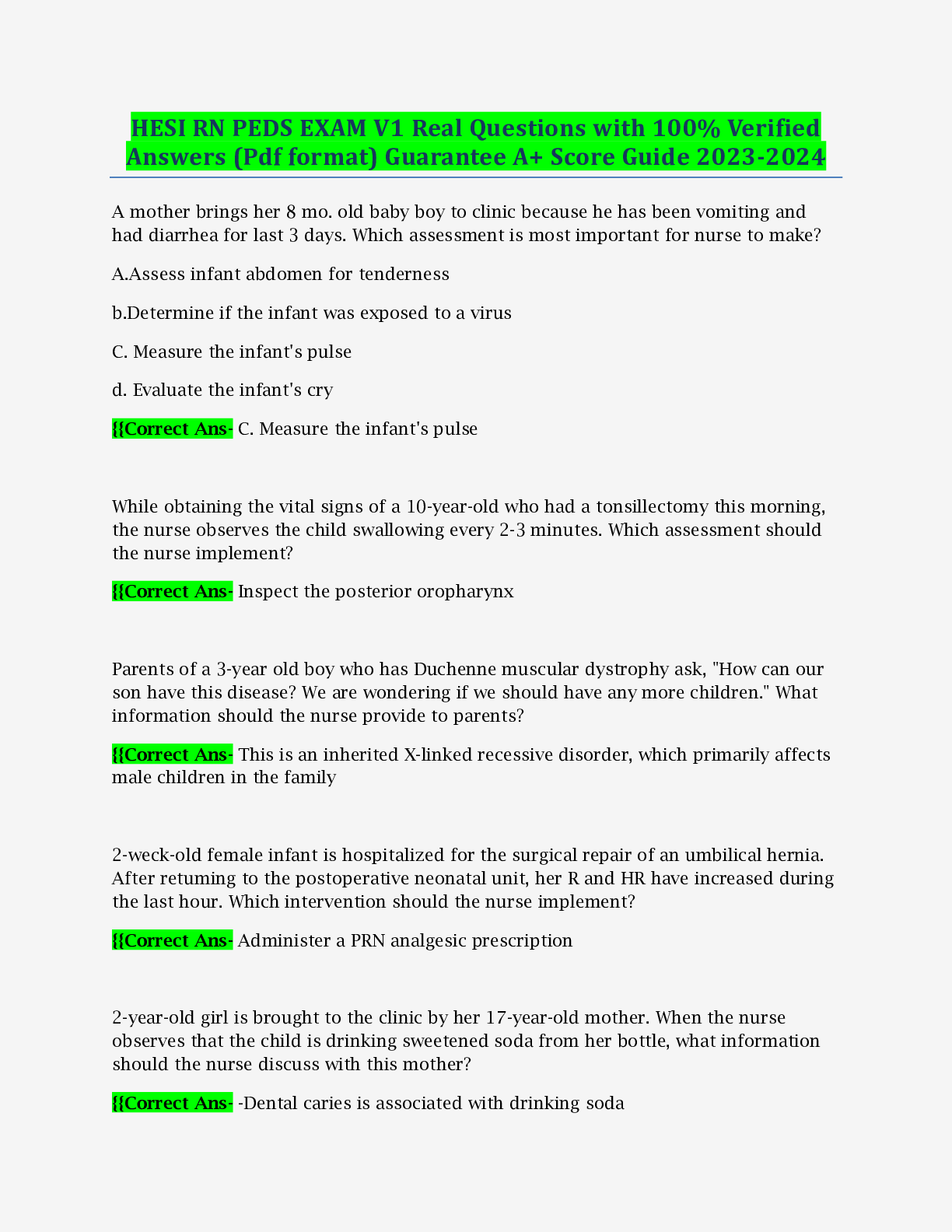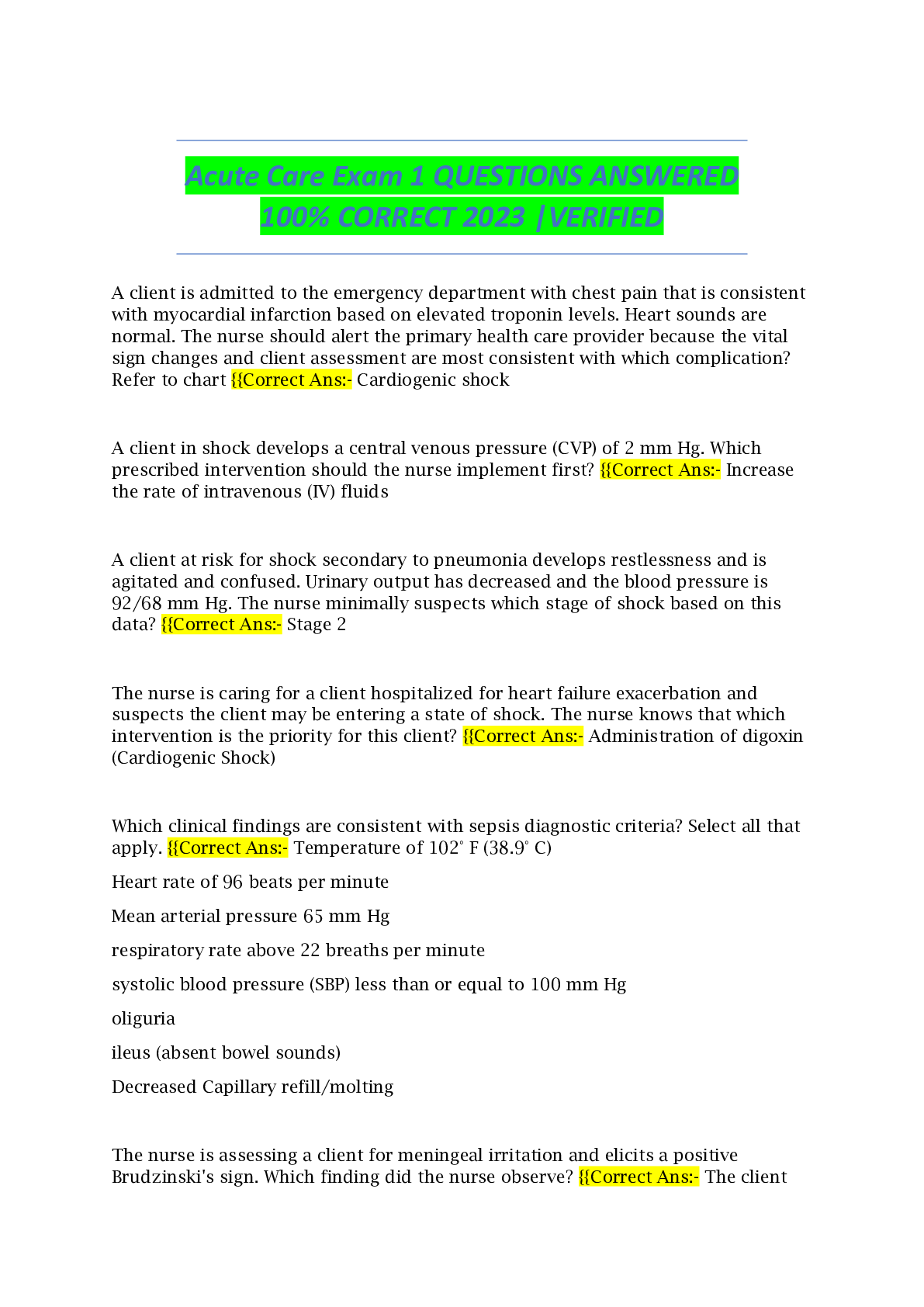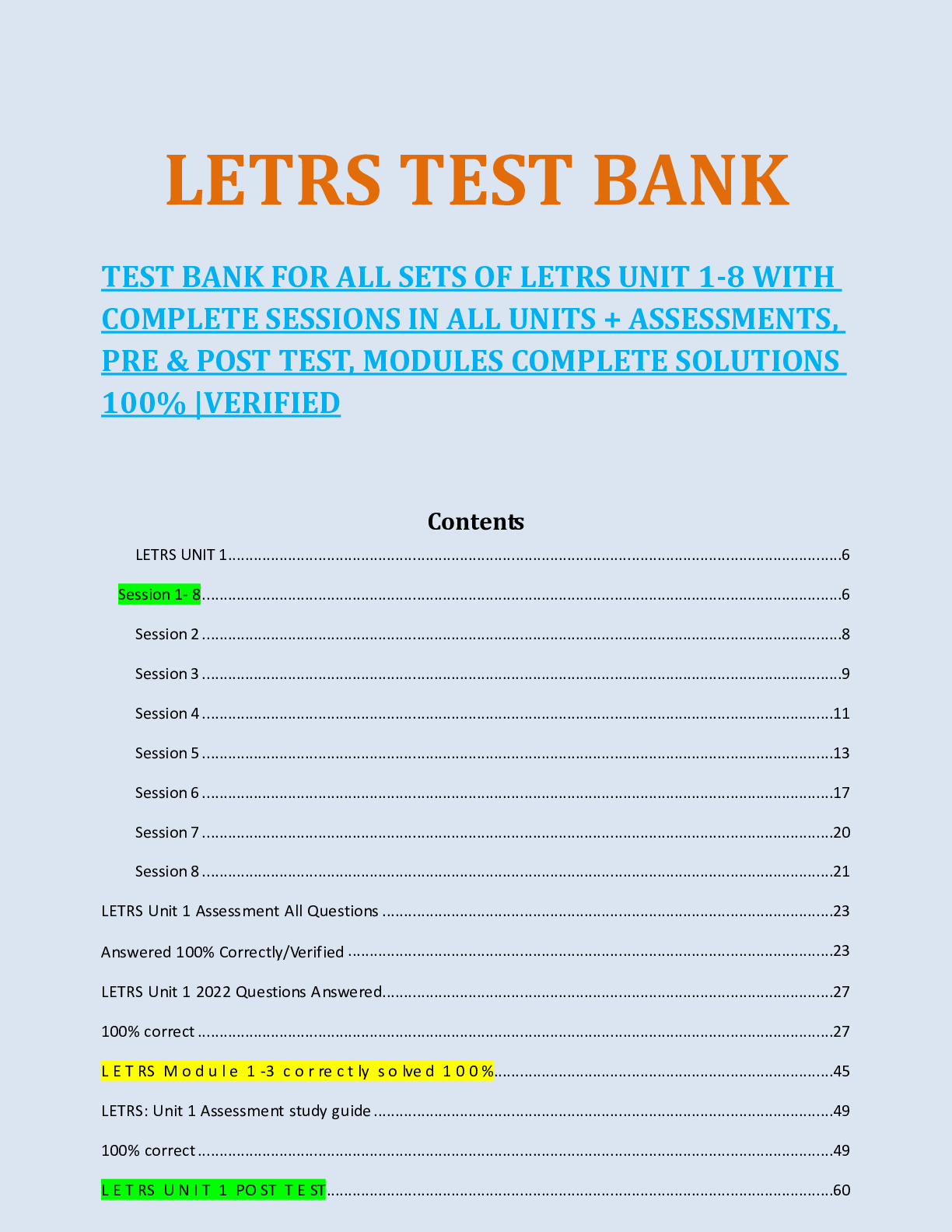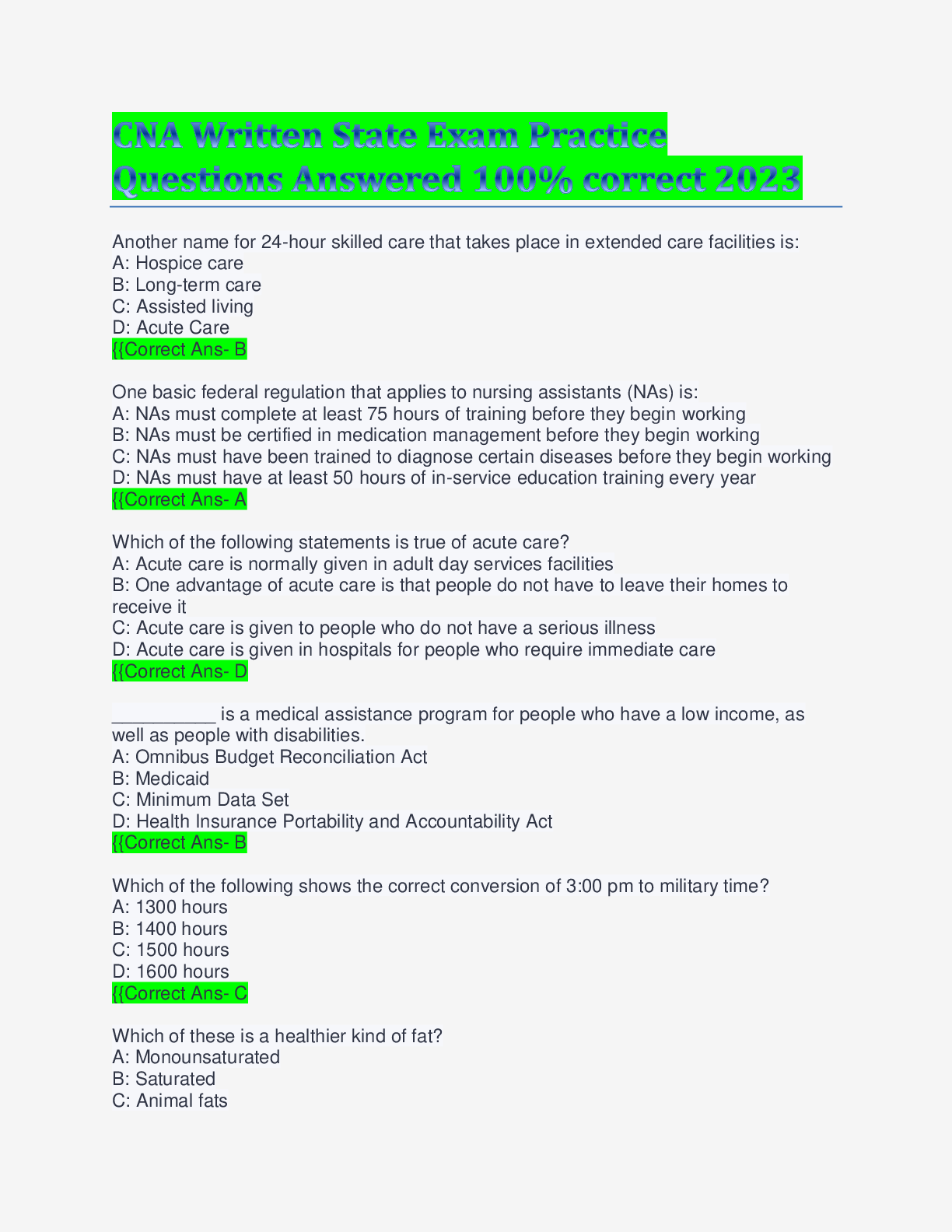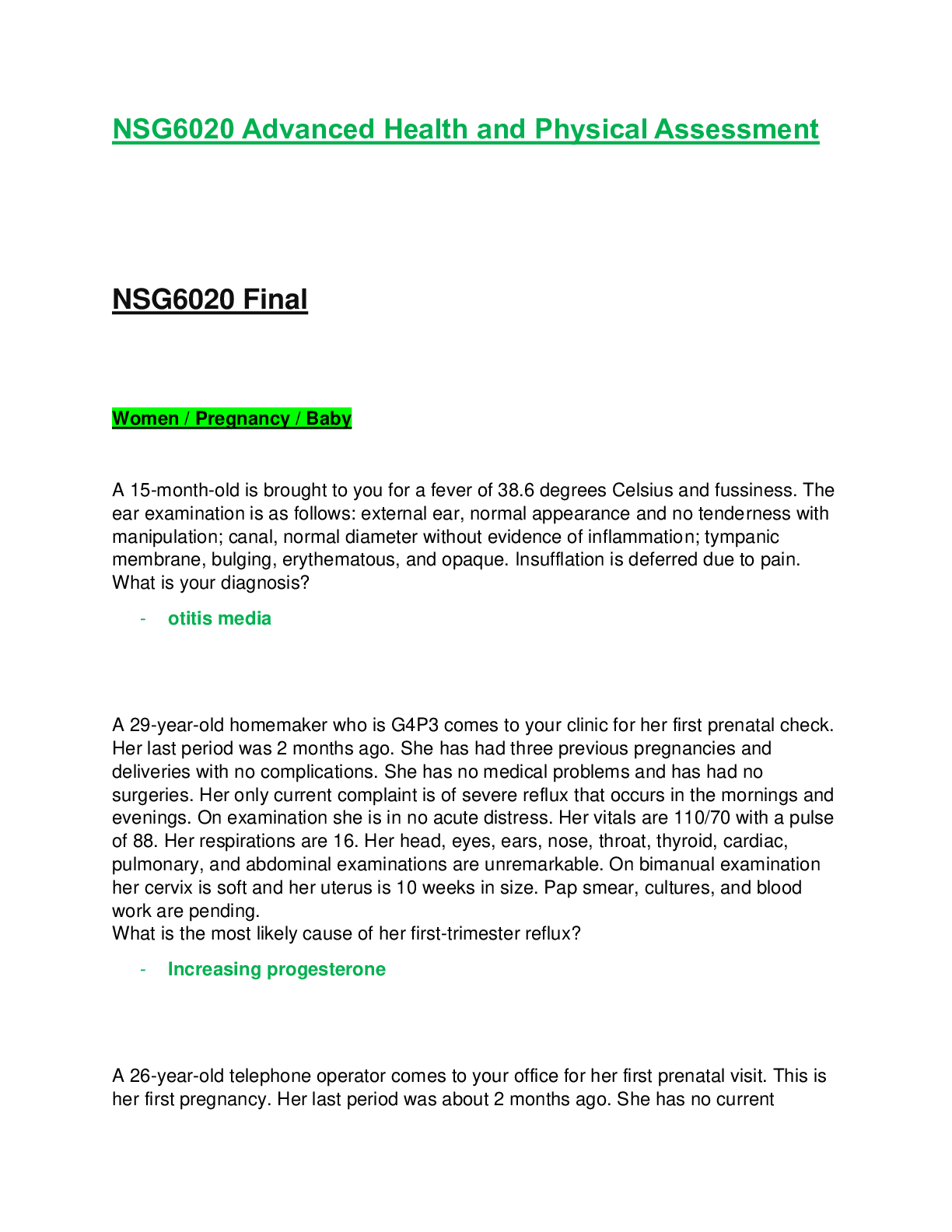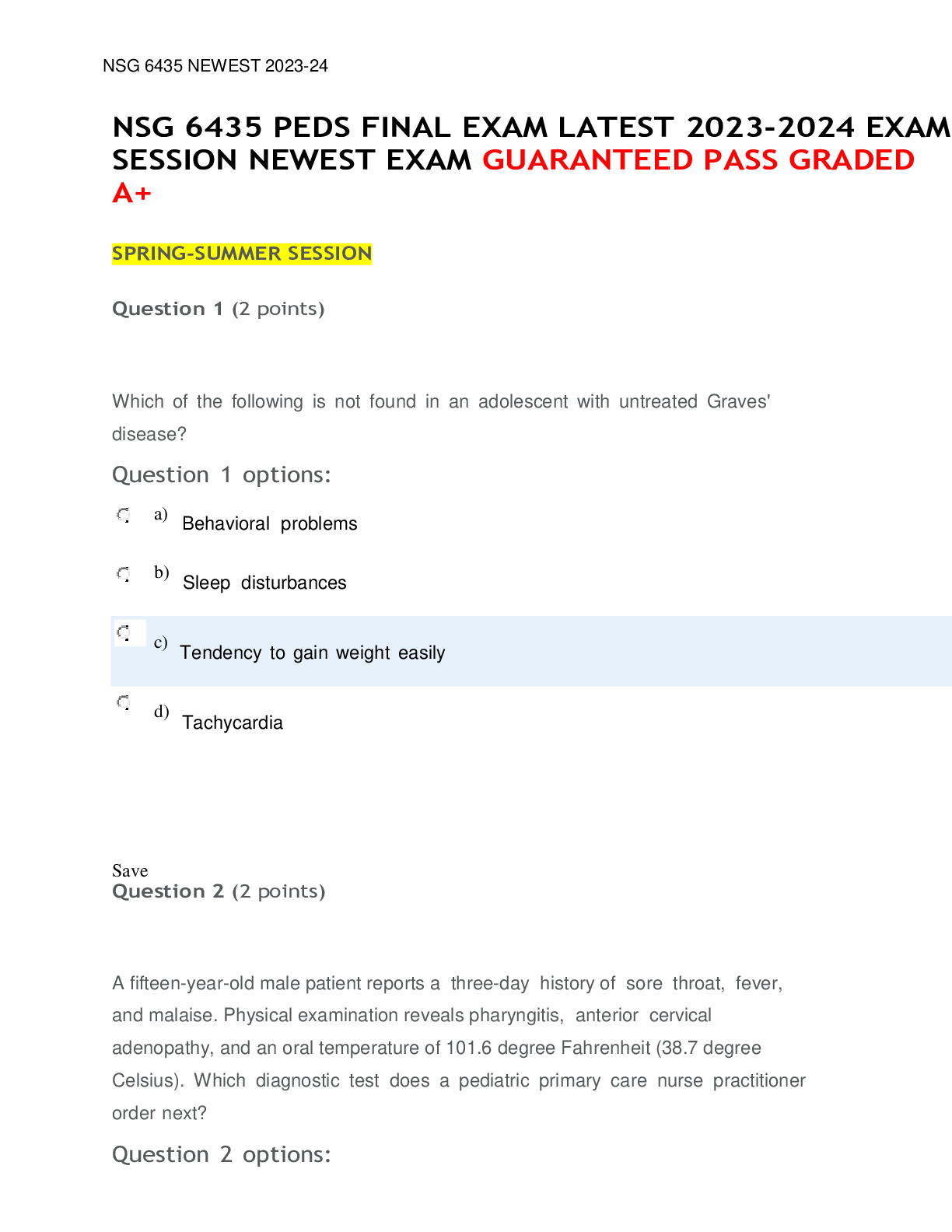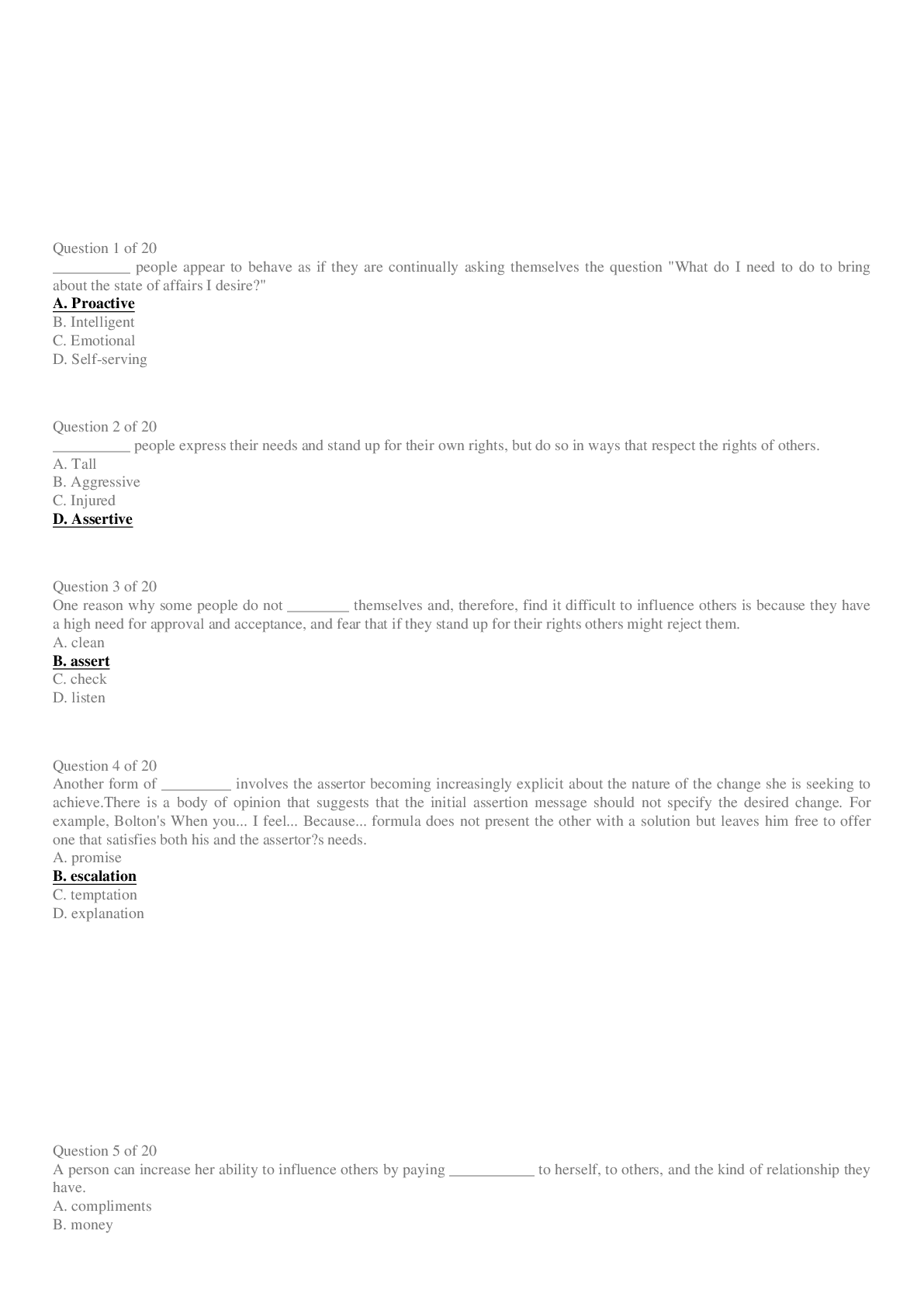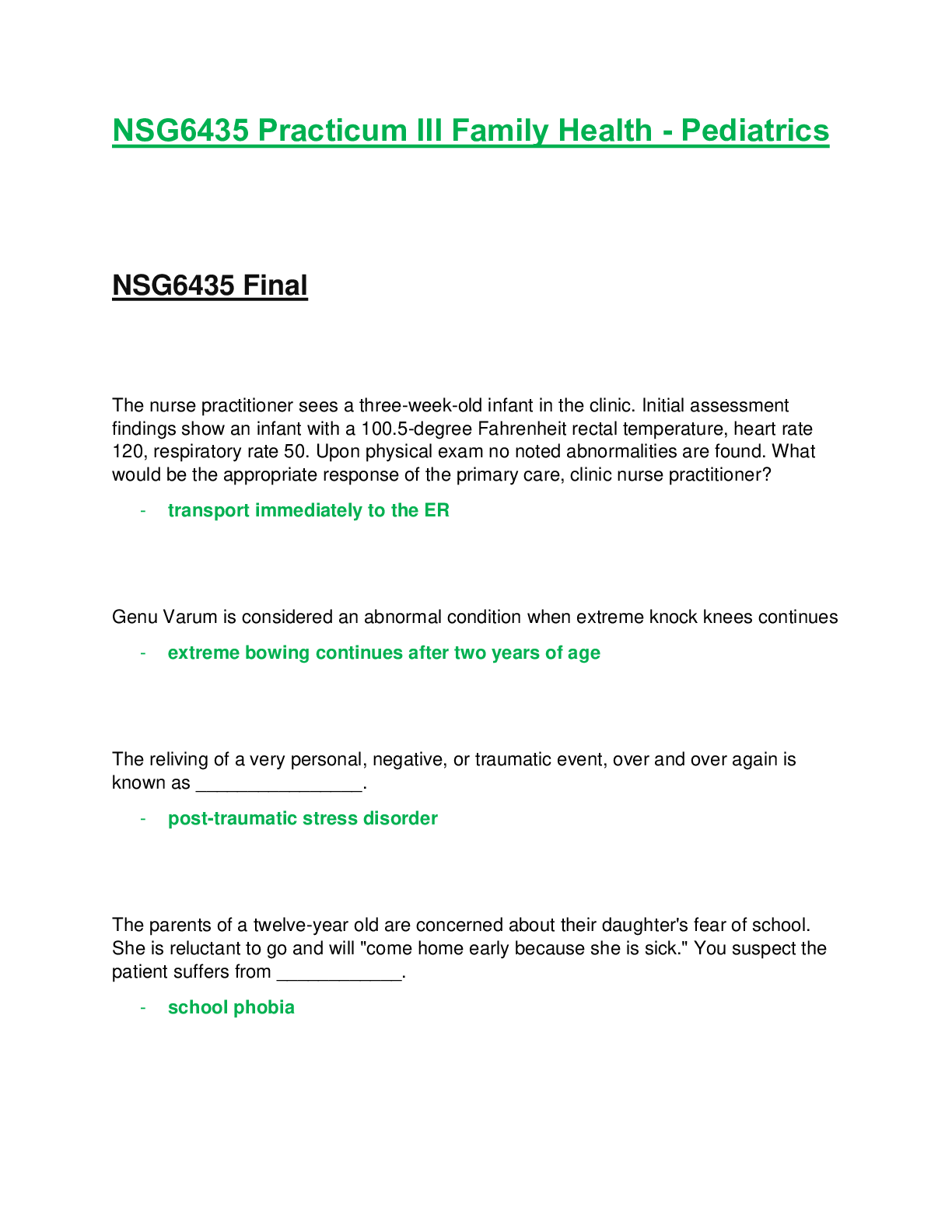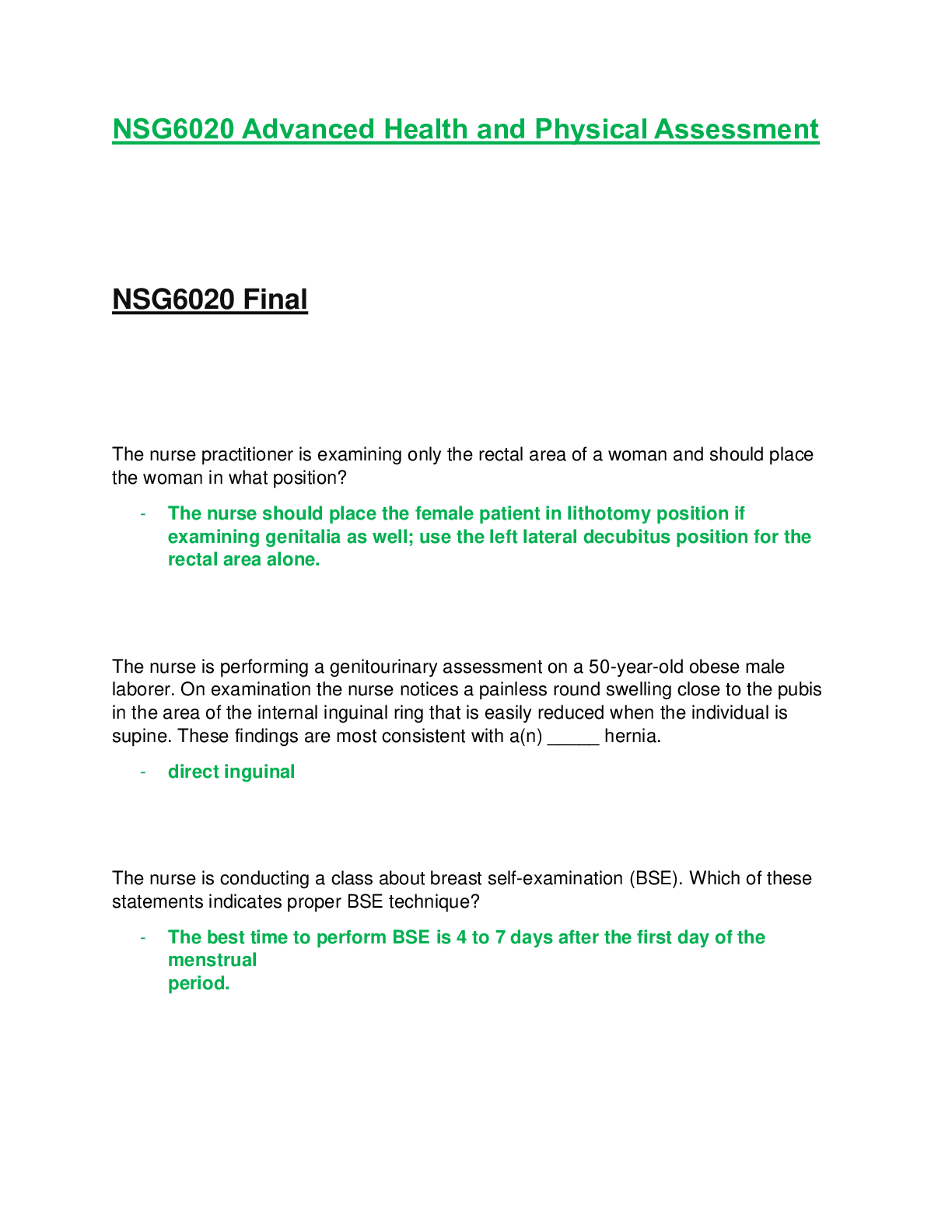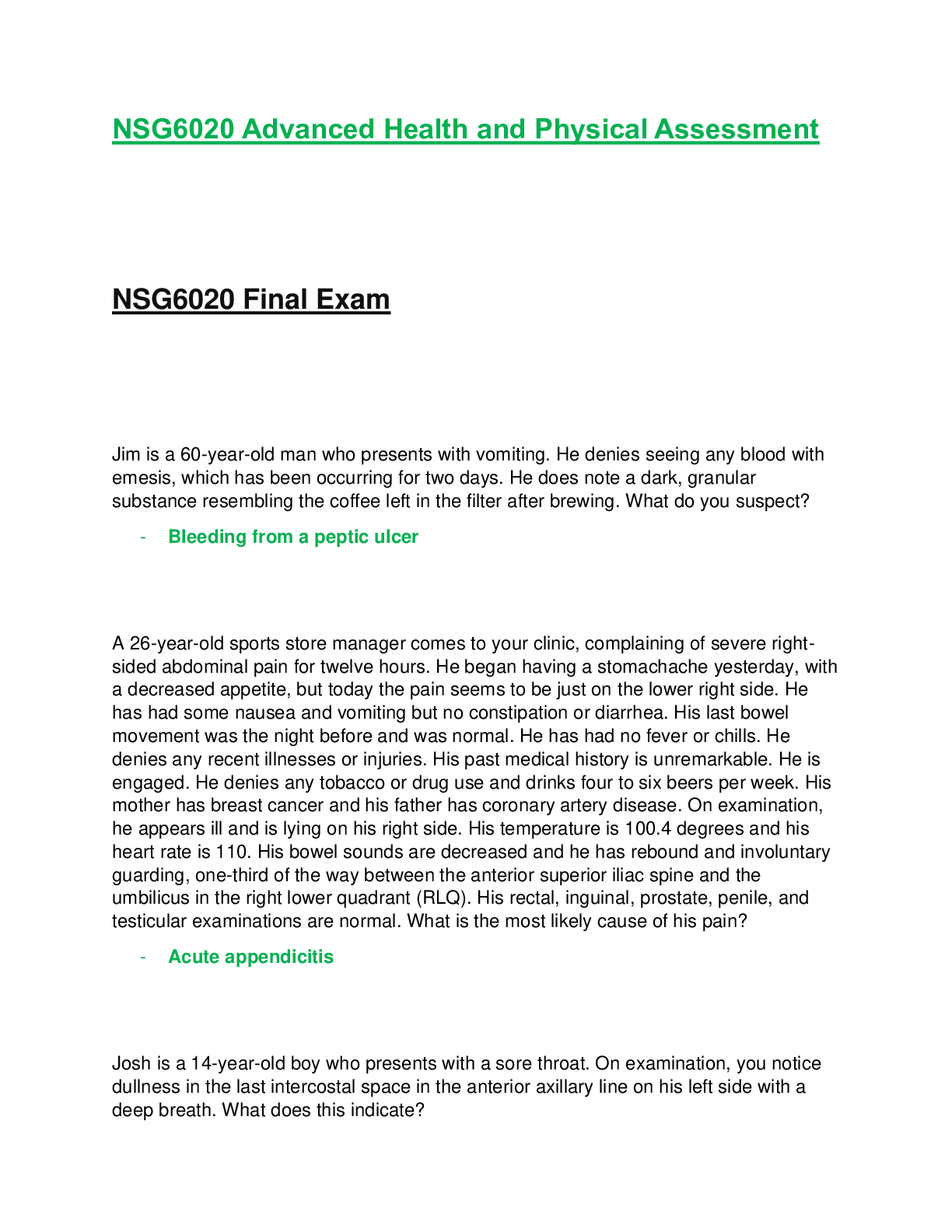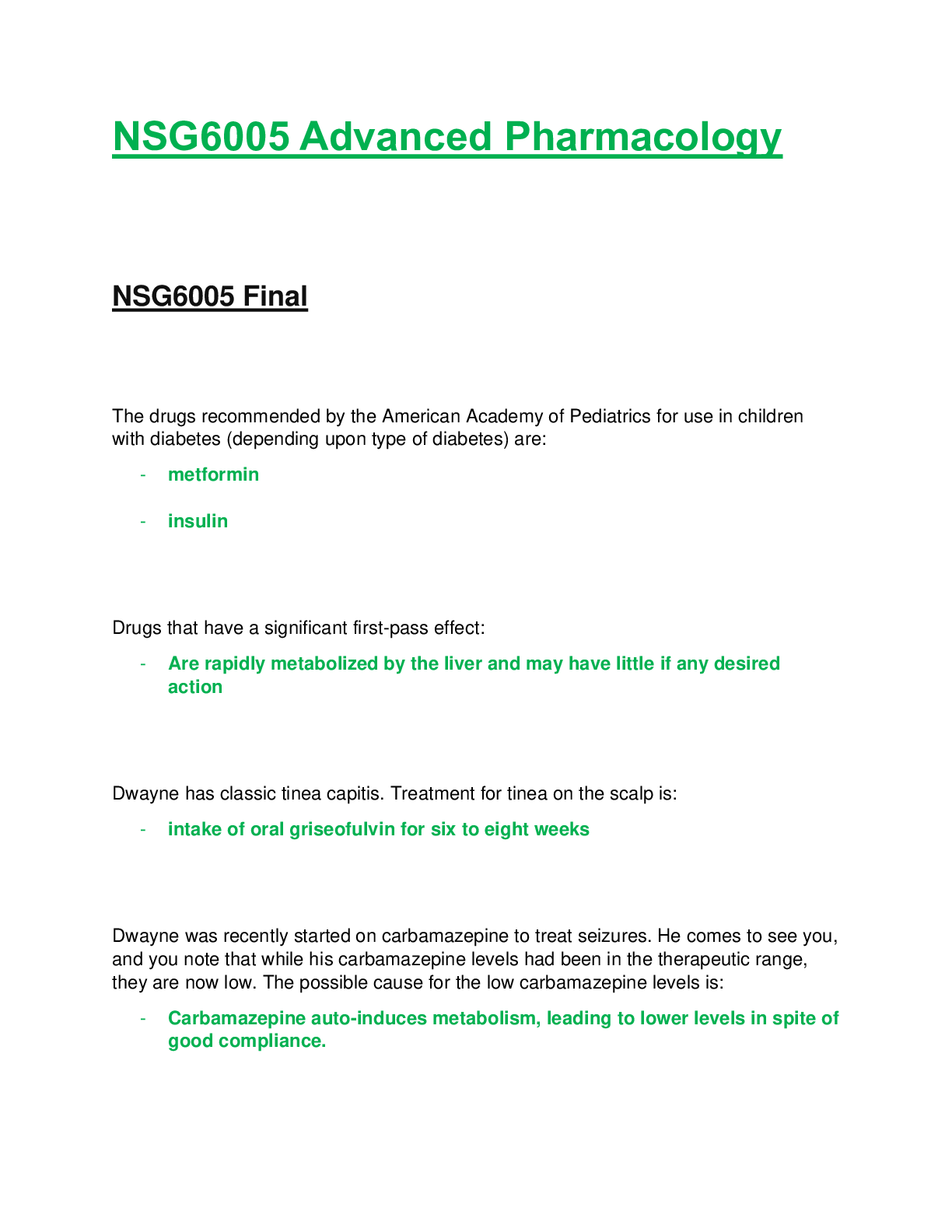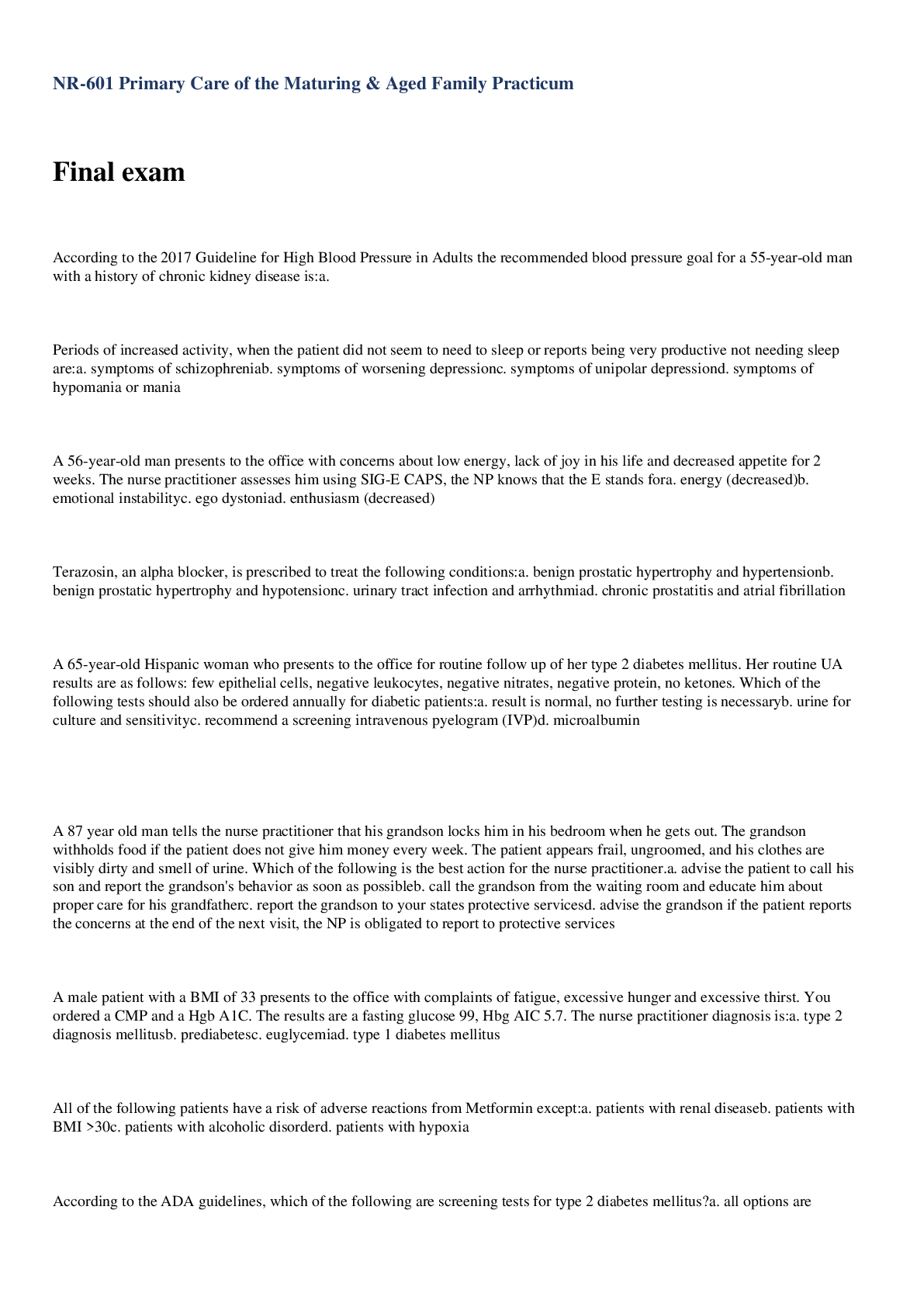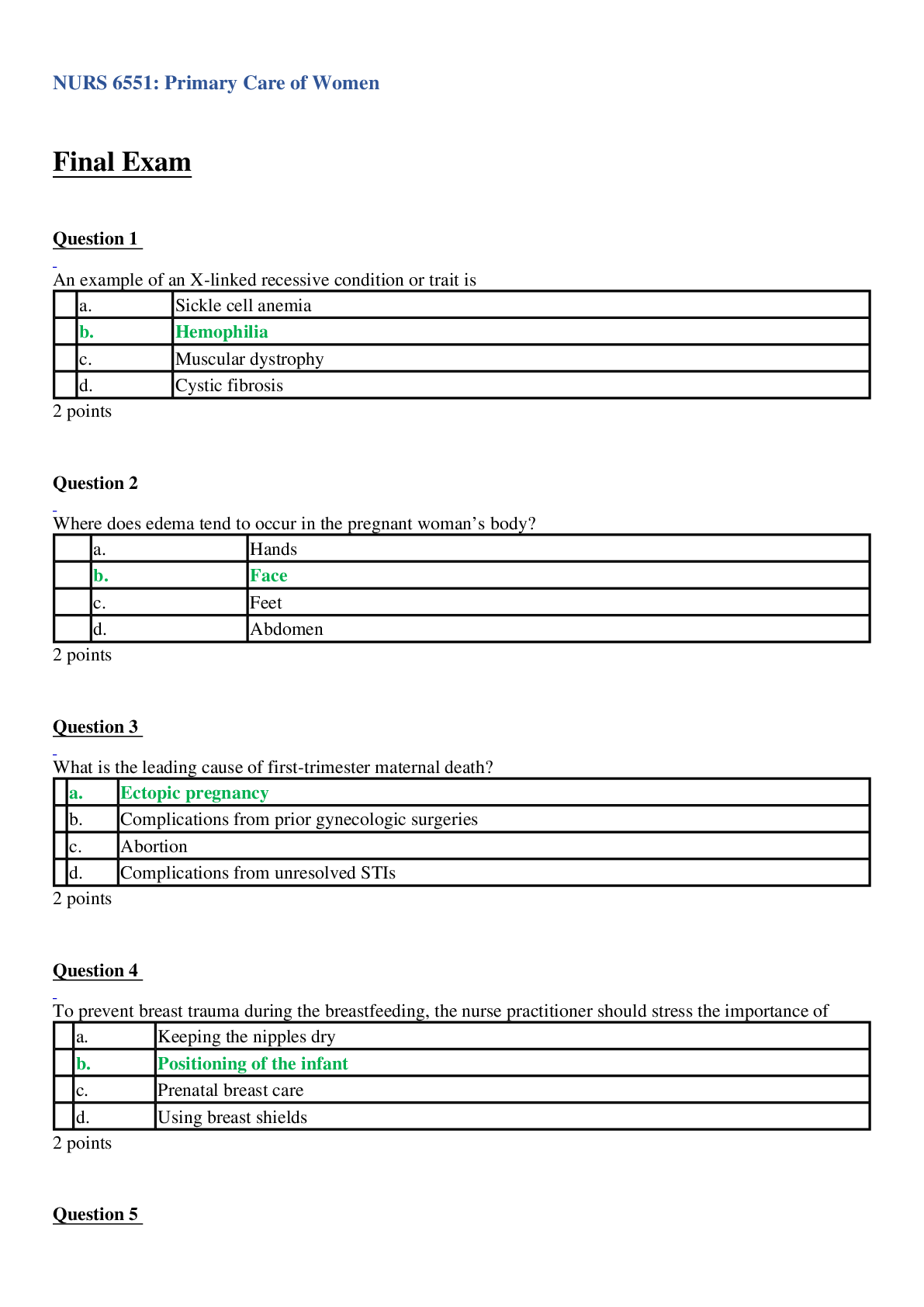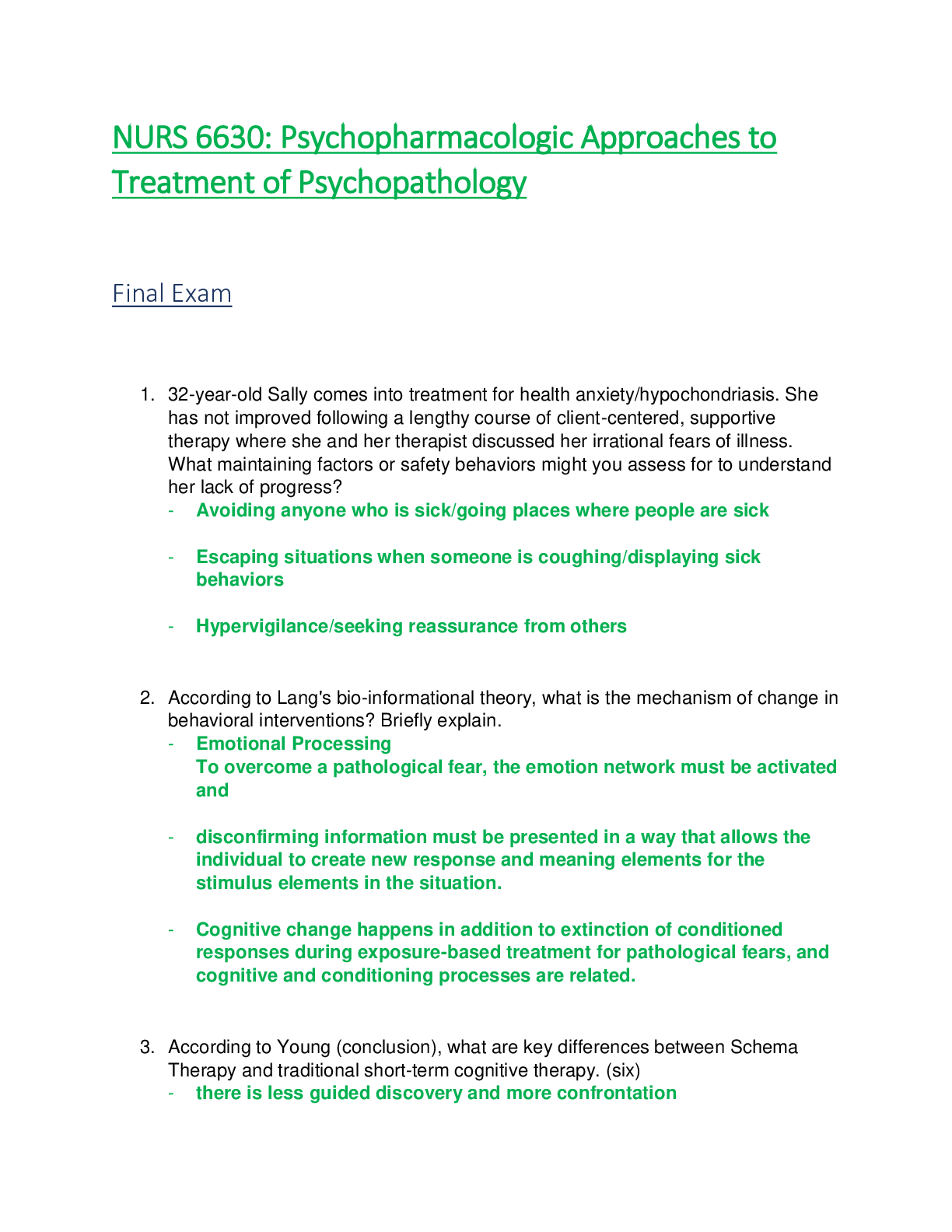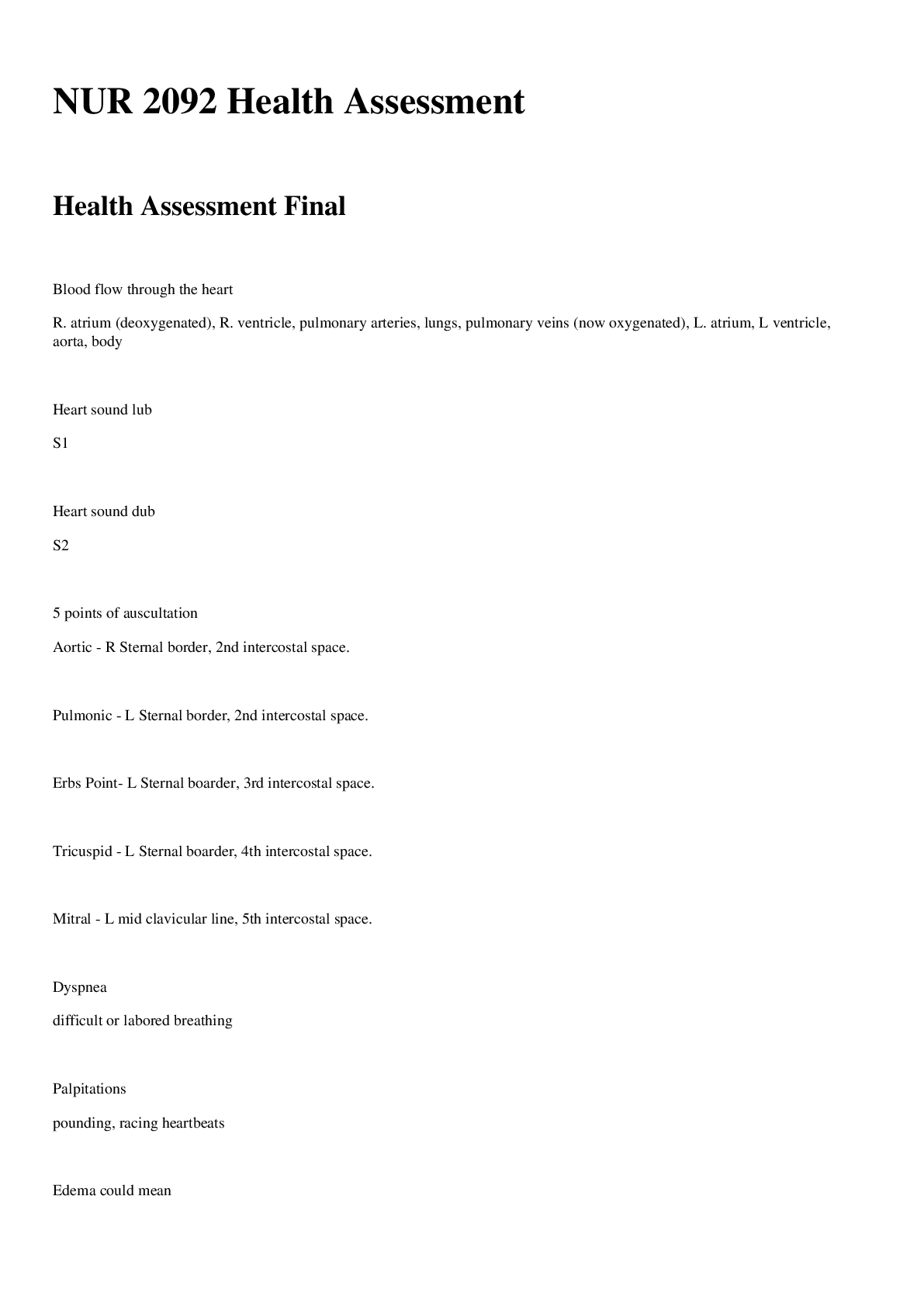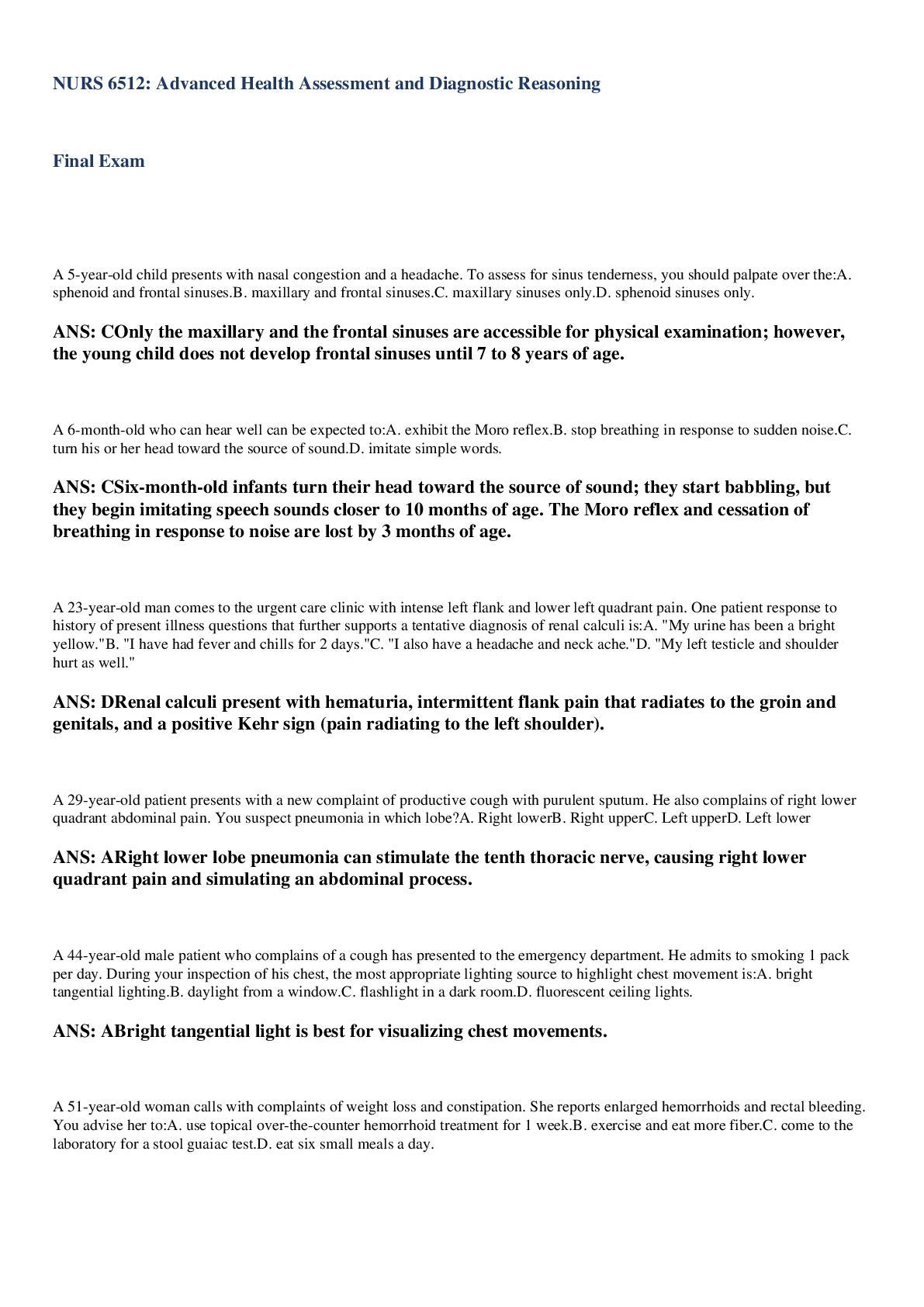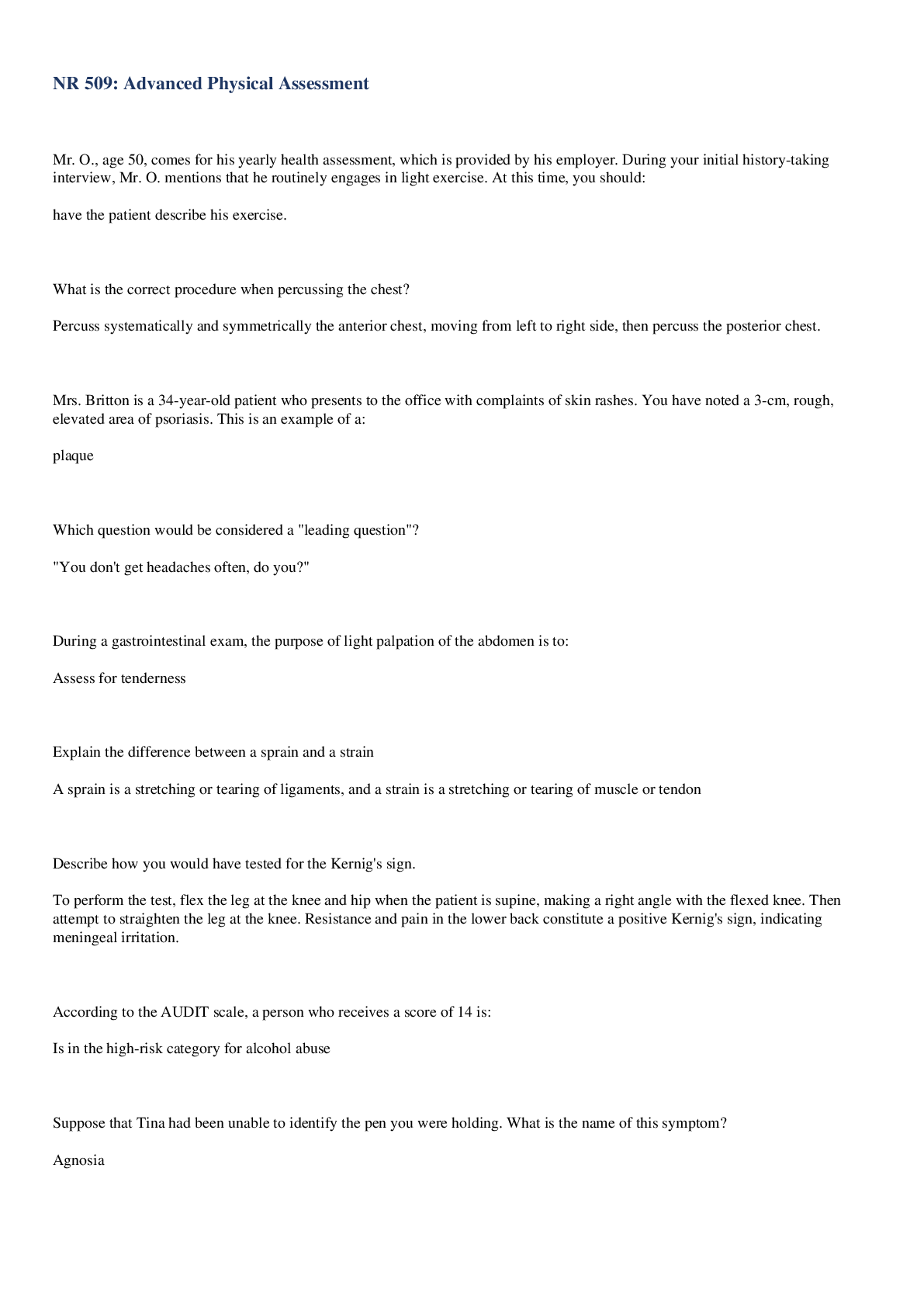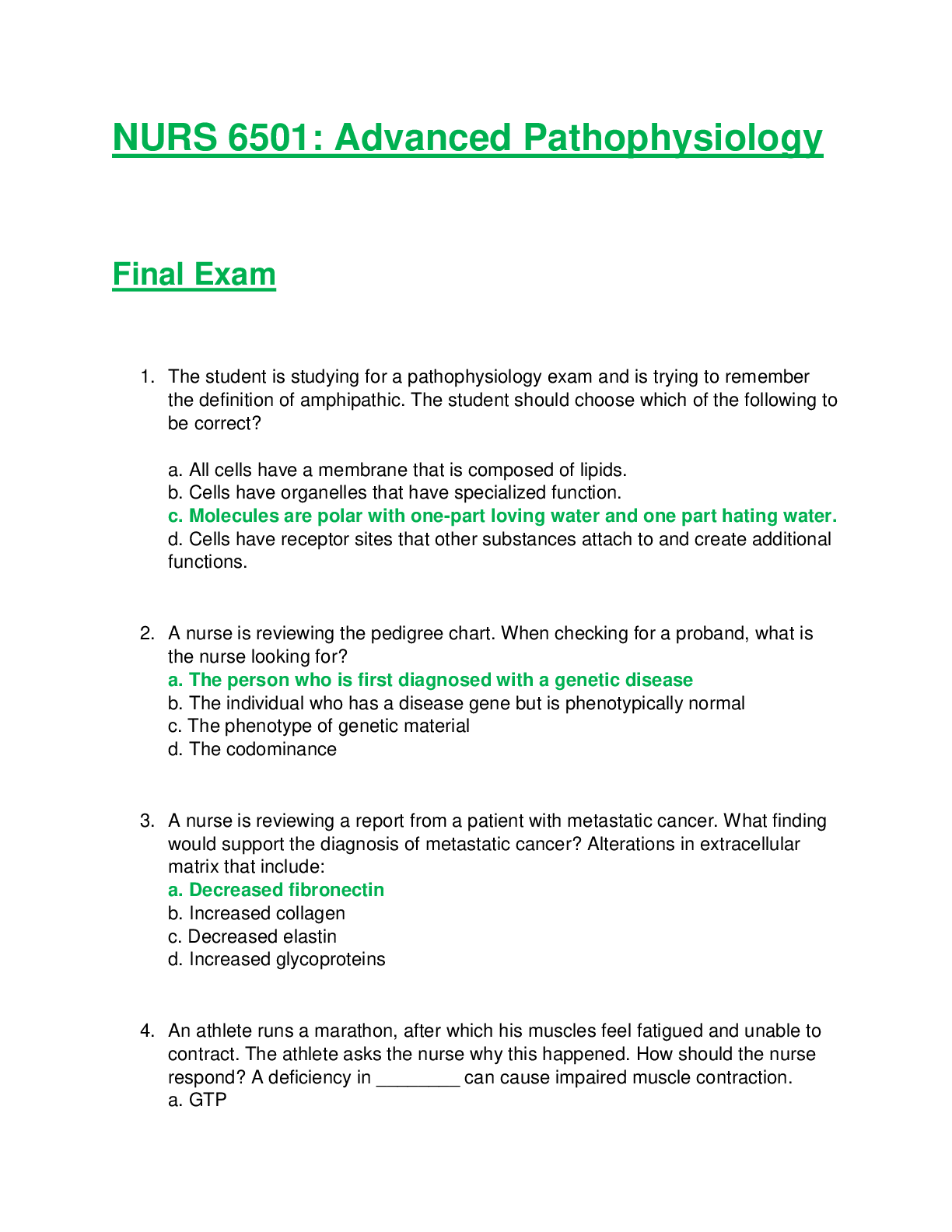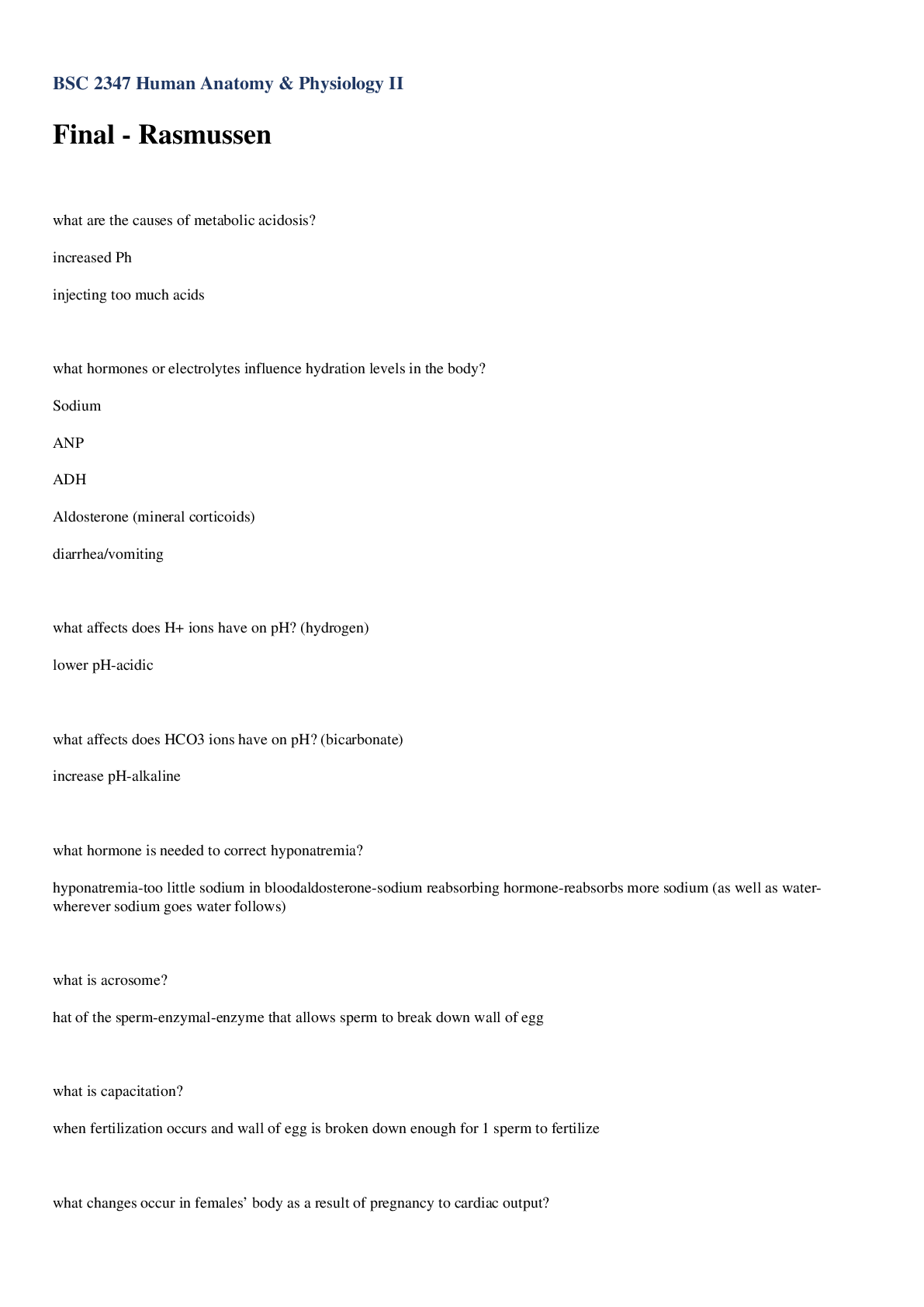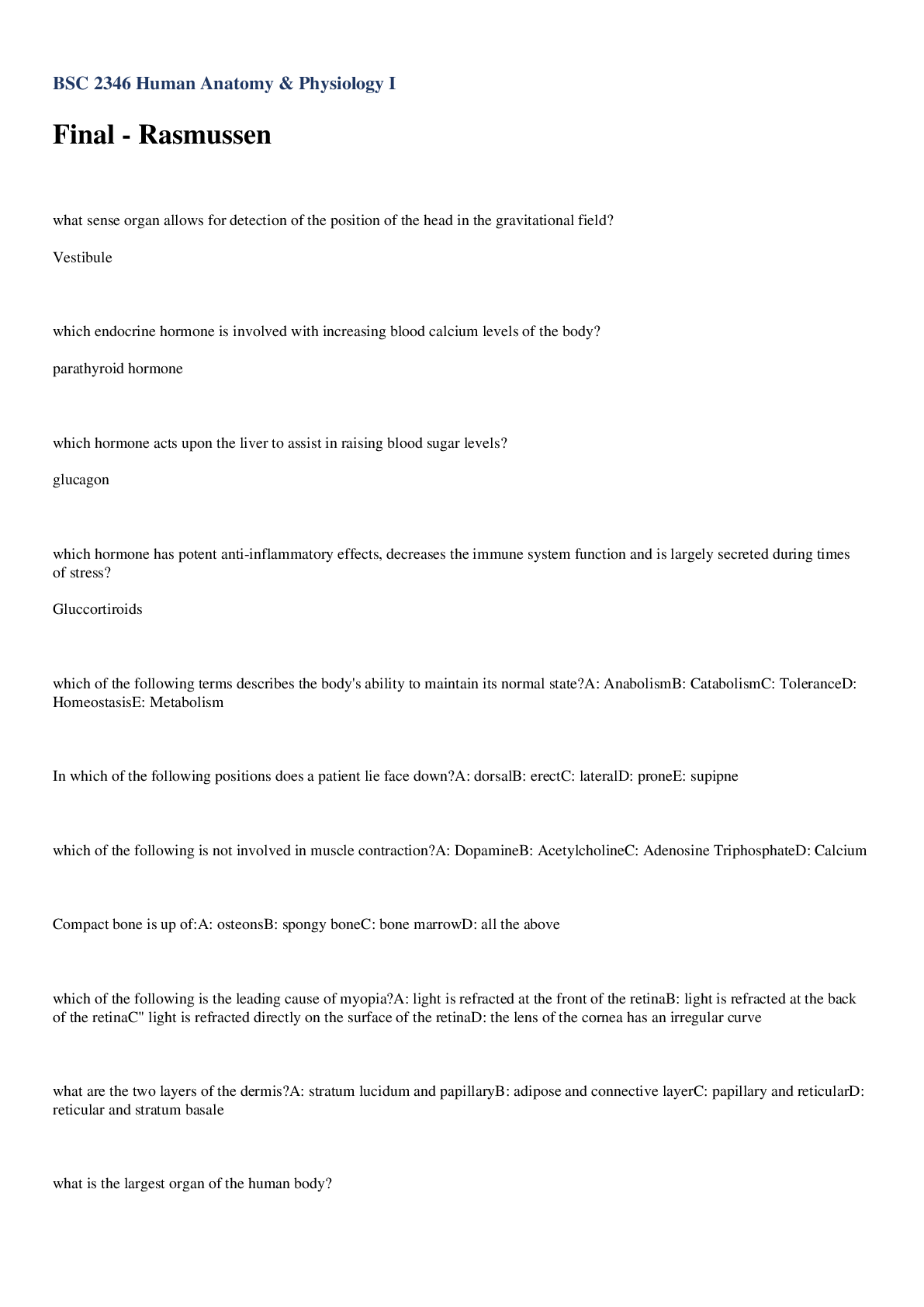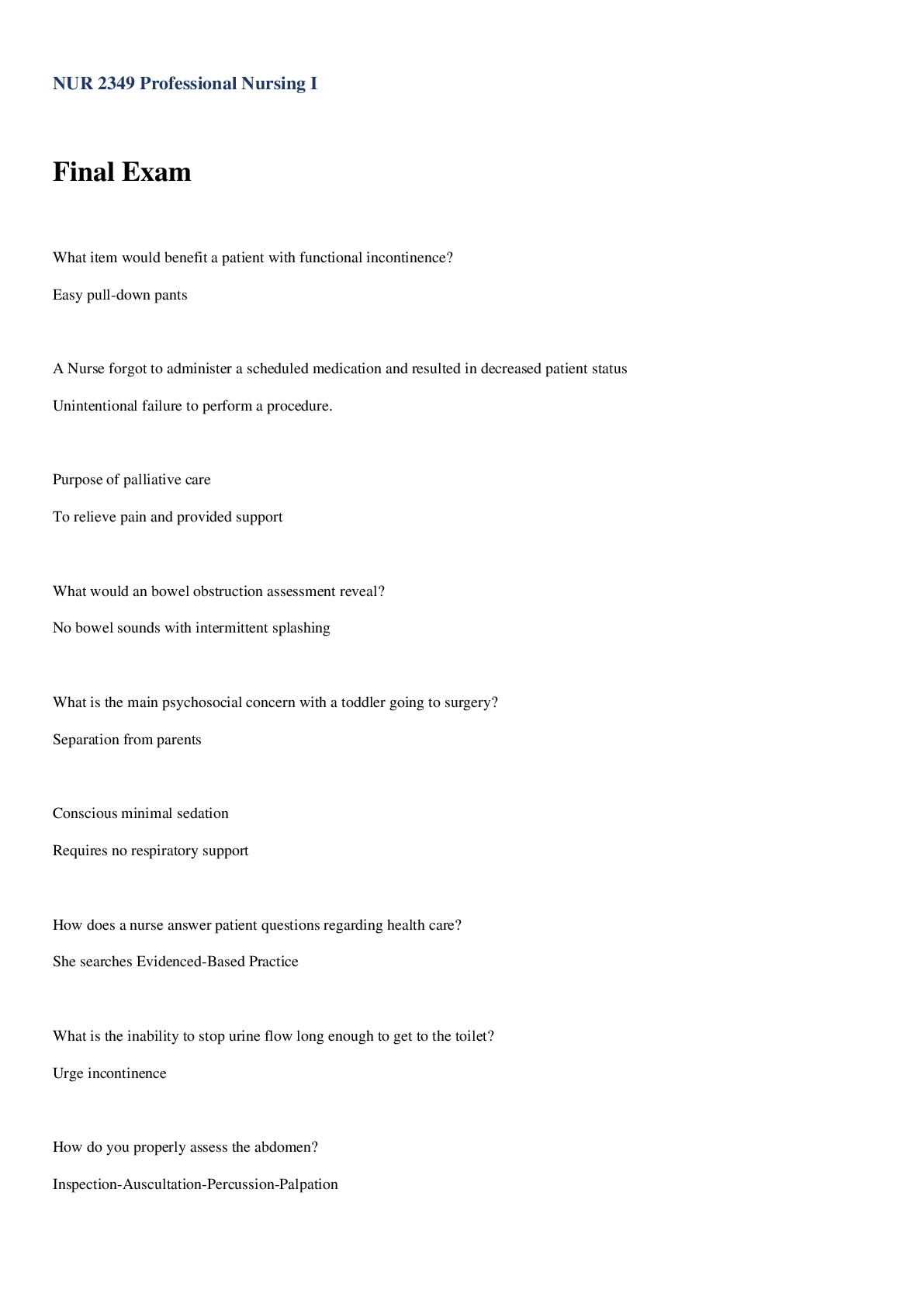Health Care > EXAM > NURS 6670 FINAL EXAM LATEST UPDATES 2023 WITH COMPLETE SOLUTION +DEFINATIONS (Walden University) (All)
NURS 6670 FINAL EXAM LATEST UPDATES 2023 WITH COMPLETE SOLUTION +DEFINATIONS (Walden University)
Document Content and Description Below
NURS 6670 FINAL EXAM LATEST UPDATES 2023 WITH COMPLETE SOLUTION +DEFINATIONS (Walden University) Q U E S T I O N 1 Collette is a 23-year-old female who presented for emergency care with her mother b... ecause her behavior has become increasingly erratic and caused her to lose her job. Her mother reports that she had never done anything like this in the past, but about 3 months ago, her boyfriend of 3 years broke up with her, and Collette began to express unrealistic beliefs that her boyfriend wanted to drive her crazy and hurt her. A gentleman trying to hail a taxi accidentally bumped into her this morning, and she started screaming that her ex-boyfriend had hired the man to throw her into the street under a car. Collette is on a 2-week suspension from her job as a restaurant server because she was combative to a customer— she accused him of colluding with her ex-boyfriend to get her fired. After this morning's incident, her mother was so worried she brought her to the emergency room. Her appearance is disheveled; she is clearly hyper alert and is crying that her boyfriend must have converted her mother to work against her. Head imaging, screening lab, and a toxicology screen are negative. A leading differential for Collette is: -Bipolar disorder -Acute psychotic episode -Schizophreniform disorder -Post-traumatic stress disorder Rationale: Collette's differential diagnosis is an acute psychotic episode, this disorder causes abnormal ideas and perceptions. Two of the main symptoms are delusions and hallucinations. Delusions are false beliefs, such as that someone is against them and hallucinations are false perceptions, such as listening, or feeling something that does not exist. Q U E S T I O N 2 Jake and Laurie are a young married couple who have been referred to mental health counseling because Jake is having disturbing sleep events. Laurie reports that on more than one occasion she has awakened to find Jake having what appears to be a panic attack, but he doesn't seem to realize it. When he finally wakes up, he is confused and doesn't really understand what happened, although he does have a sense of intense fear. This has happened twice in the last 2 weeks, and the last time Laurie heard him screaming. Jake is now a bit afraid to go to sleep and as a result does not feel well the next day. The PMHNP recognizes that sleep terrors in adults: -Are often associated with trauma or psychiatric problems -Represent a disorder of REM sleep -May be a symptom of temporal lobe epilepsy -Is treated with a cycle of sleep deprivation Q U E S T I O N 3 Jack is a 27-year-old male who has a history of paranoid schizophrenia that first became apparent approximately 10 years ago. He developed paranoid delusions and eventually decompensated to the point that he required inpatient stabilization. At the time, he was started on conventional antipsychotics, but due to intolerable adverse effects he was switched to haloperidol. It worked well, but whenever he stopped taking it, symptoms would recur. After several hospitalizations, he was stabilized. The neurophysiologic theory of schizophrenia suggests that Jack's symptoms were a result of: -Increased dopamine activity in the mesolimbic pathway -Increased dopamine activity in the mesocortical pathway -Increased glutamate in the prefrontal cortex -Increased glutamate in the hippocampus Q U E S T I O N 4 Johanne is a 22-year-old female who is being treated for narcolepsy. She is attempting to implement a regimen of forced daytime naps in an effort to manage her condition without pharmacotherapy as she is generally averse to taking medications. While following Johanne, the PMHNP should be alert to signs and symptoms of -Suicidality -Depression -Hyperphagia -Disinhibition Narcolepsy A sleep disorder characterized by uncontrollable sleep attacks. The sufferer may lapse directly into REM sleep, often at inopportune times. Q U E S T I O N 5 The PMHNP is asked to prepare a presentation for non-nursing health care workers in a local long-term care facility on the various causes of cognitive impairment in the elderly. A case presentation approach is used to reinforce principles of identifying delirium, which needs to be reported to the patient's attending provider right away. The case should emphasize which of the following features as being closely correlated with delirium? -Perceptual disturbances -Rapid onset -Agitation -Abnormal sleep patterns Q U E S T I O N 6 Valerie is a 27-year-old woman who has been referred by her primary care provider. She was initially diagnosed with major depressive episode following a breakup with her boyfriend of 7 years. They moved into a house together 1 year ago, but within a few months the boyfriend moved out. Valerie was unresponsive to medication for depression and was referred to the mental health clinic. During this initial psychiatric evaluation, the PMHNP learns that a primary reason for the breakup was that Valerie had an extensive routine every night of repeatedly checking every door and window in the home to ensure that they were locked. Valerie's nighttime routine is exhaustive and involves checking every door and window at least four times. She has a remote history of being attacked in her home while alone and states that she is unable to go to bed until she is certain that every door and window is locked. When considering diagnostic criteria for OCD, the PMHNP needs further assessment to ascertain which diagnostic criteria? -The patient has tried unsuccessfully to suppress the urge to repeatedly check locks -The compulsive activities are time-consuming to the extent that at least 1 hour daily is spent on them -The disturbance is not better explained as the symptoms of another mental disorder -The patient has good or fair insight with respect to the appropriateness of her behaviors Q U E S T I O N 7 Michael is an 18-year-old male who is presented to care at the urging of his parents. He has never had any significant medical or psychiatric problems in the past, but during his first semester at college he has developed a very alarming pattern of excess sleep. He is missing classes and is in danger of losing a scholarship. He is sleeping normally at night but apparently is having these very long episodes of napping and sleeping during the day. When he is awake, he tends to be rather withdrawn. His parents have taken him to their family practitioner as they thought he might be using drugs. A full exam, laboratory assessment, and toxicology screen are all normal, and there is no apparent cause for this sleepiness. While very rare, the PMHNP considers Kleine-Levin syndrome and further assesses for coincident onset of: -Narcolepsy -Mood disorder -Hyper sexuality -Alcohol Kleine-Levin syndrome Recurrent hypersomnia with daytime sleepiness, hyperphagia, hypersexuality, aggression. Kleine Levin syndrome is a rare disorder characterized by recurrent episodes of excessive sleep (hypersomnia) along with cognitive and behavioral changes. Affected individuals may sleep for up to 20 hours per day during an episode. These episodes usually last for a few days to a few weeks. Q U E S T I O N 8 The primary differentiating feature between mild cognitive impairment (MCI) and Alzheimer's dementia is: -The presence of the apolipoprotein E4 gene -Performance on objective neuropsychiatric testing -Presence or absence of functional impairment -Atrophy of the hippocampal volume Q U E S T I O N 9 Physiologic assessment of patients with paraphilia’s has demonstrated that most them have: -Abnormal hormone levels -Hard or soft neurological signs -Chromosomal abnormalities -Electroencephalogram (EEG) abnormalities Q U E S T I O N 10 Donna is a 41-year-old woman who is being evaluated at the request of her primary care provider for obsessive compulsive disorder. Which of the following aspects of Donna's family medical history should prompt an immediate referral to a neurologist? -Father committed suicide at age 38 -Mother died from Huntington’s chorea -Sister has temporal lobe epilepsy [Show More]
Last updated: 1 year ago
Preview 1 out of 32 pages

Reviews( 0 )
Document information
Connected school, study & course
About the document
Uploaded On
May 05, 2023
Number of pages
32
Written in
Additional information
This document has been written for:
Uploaded
May 05, 2023
Downloads
0
Views
74

